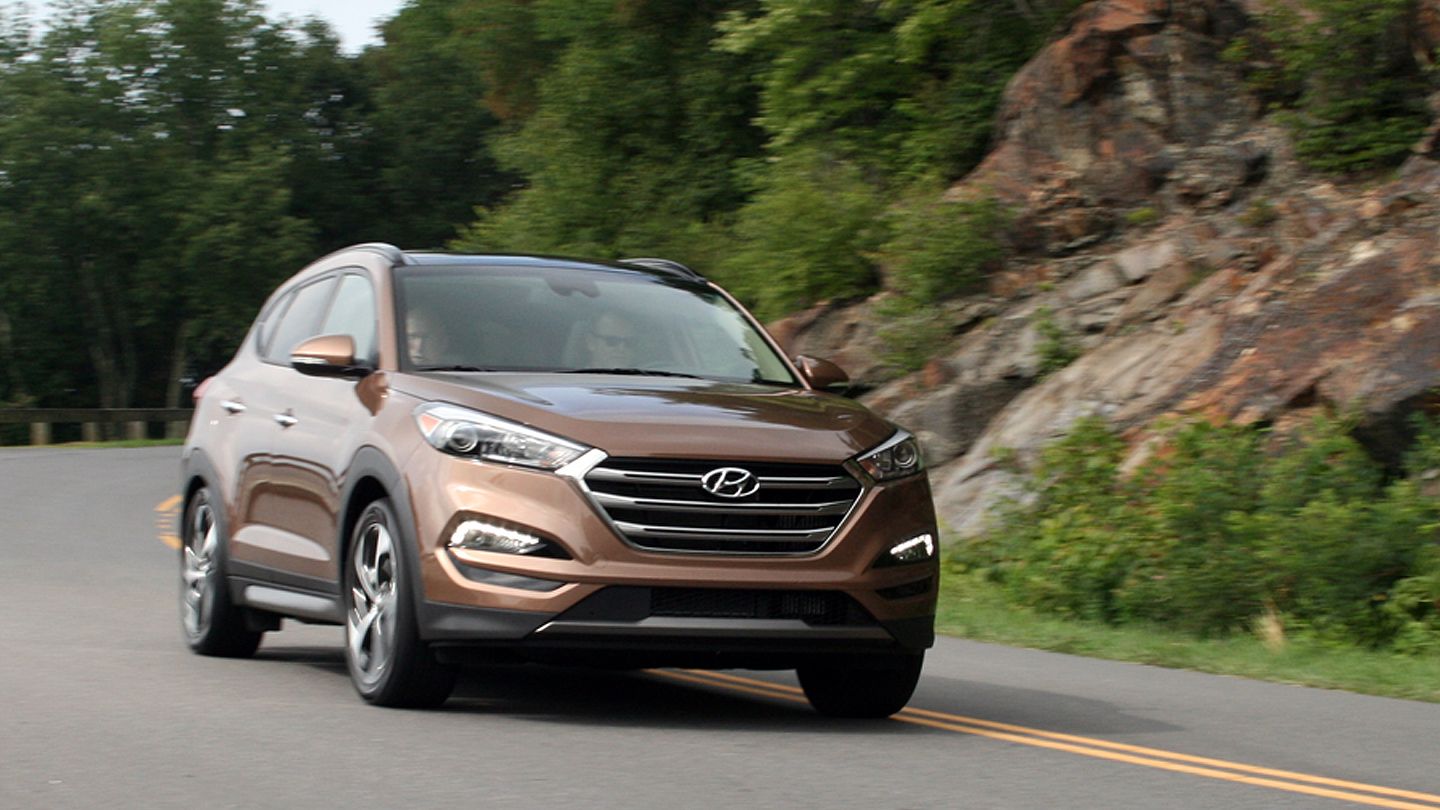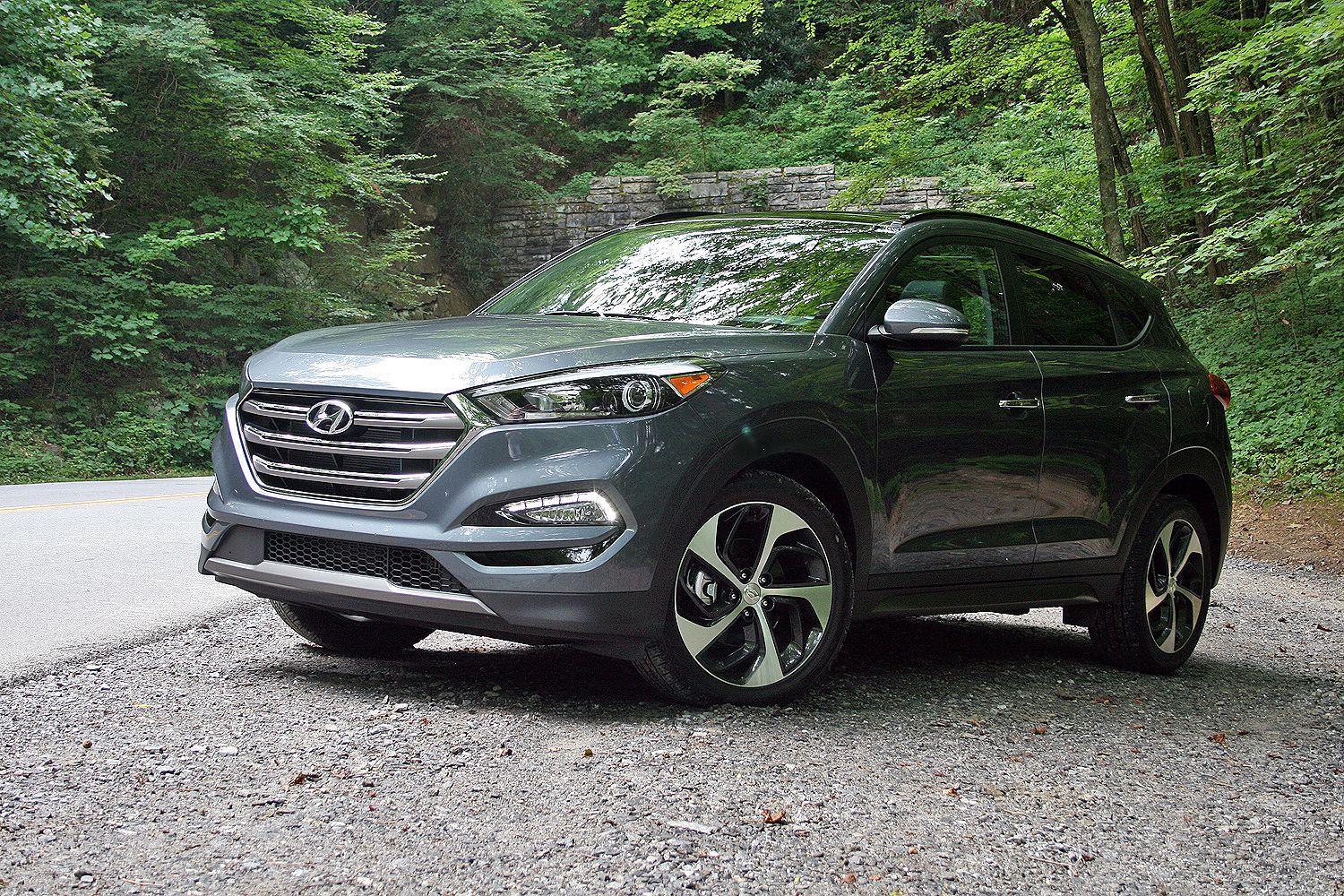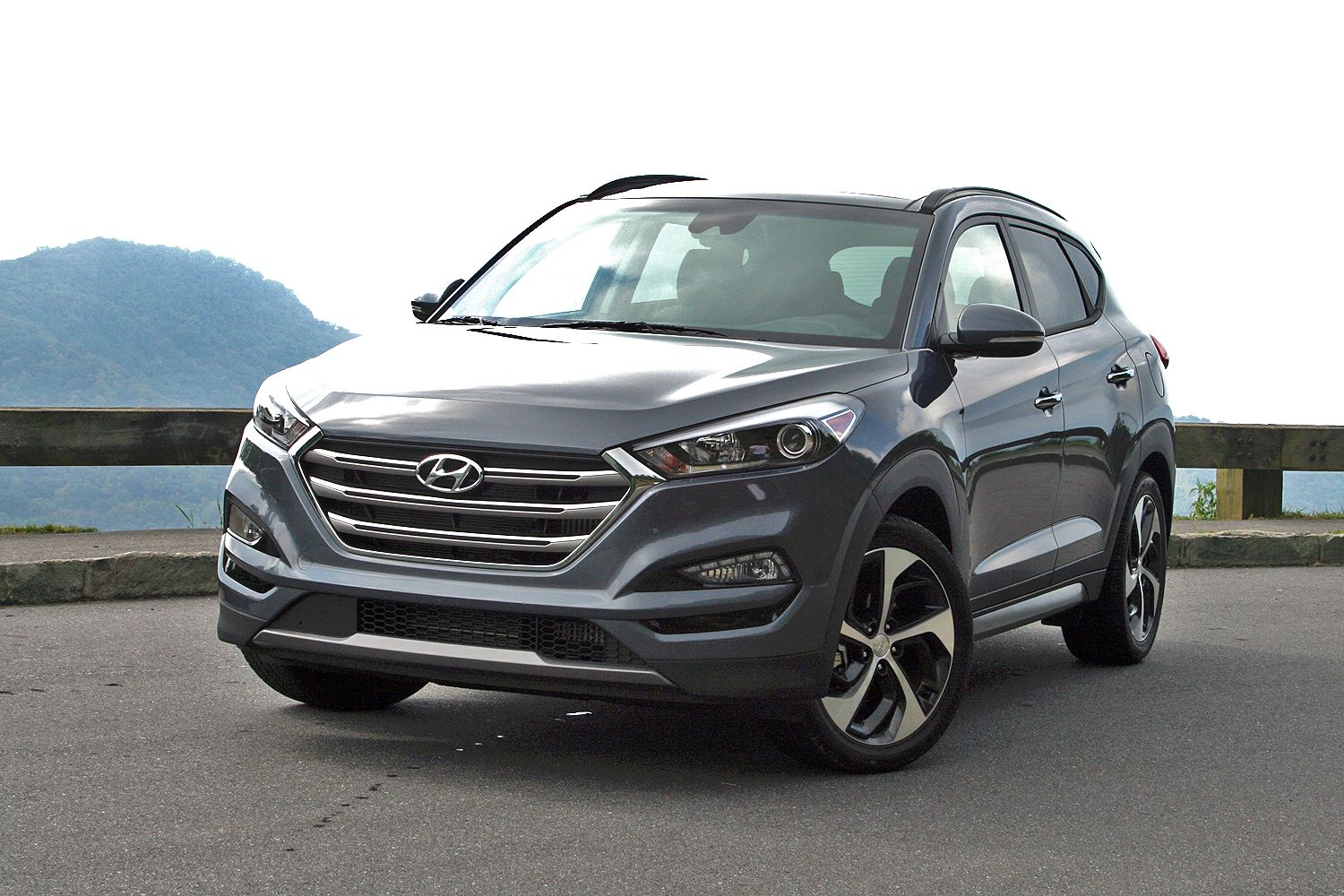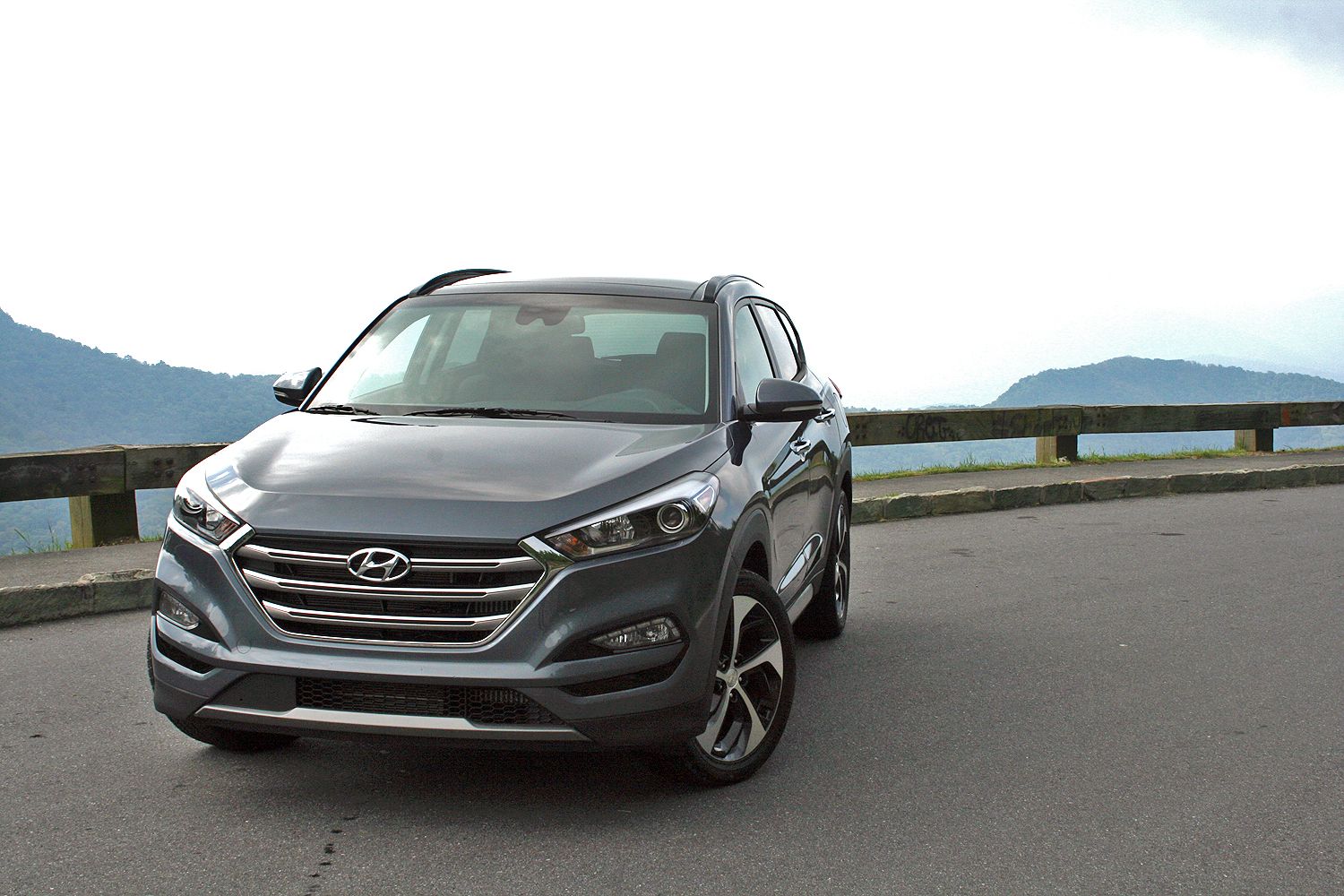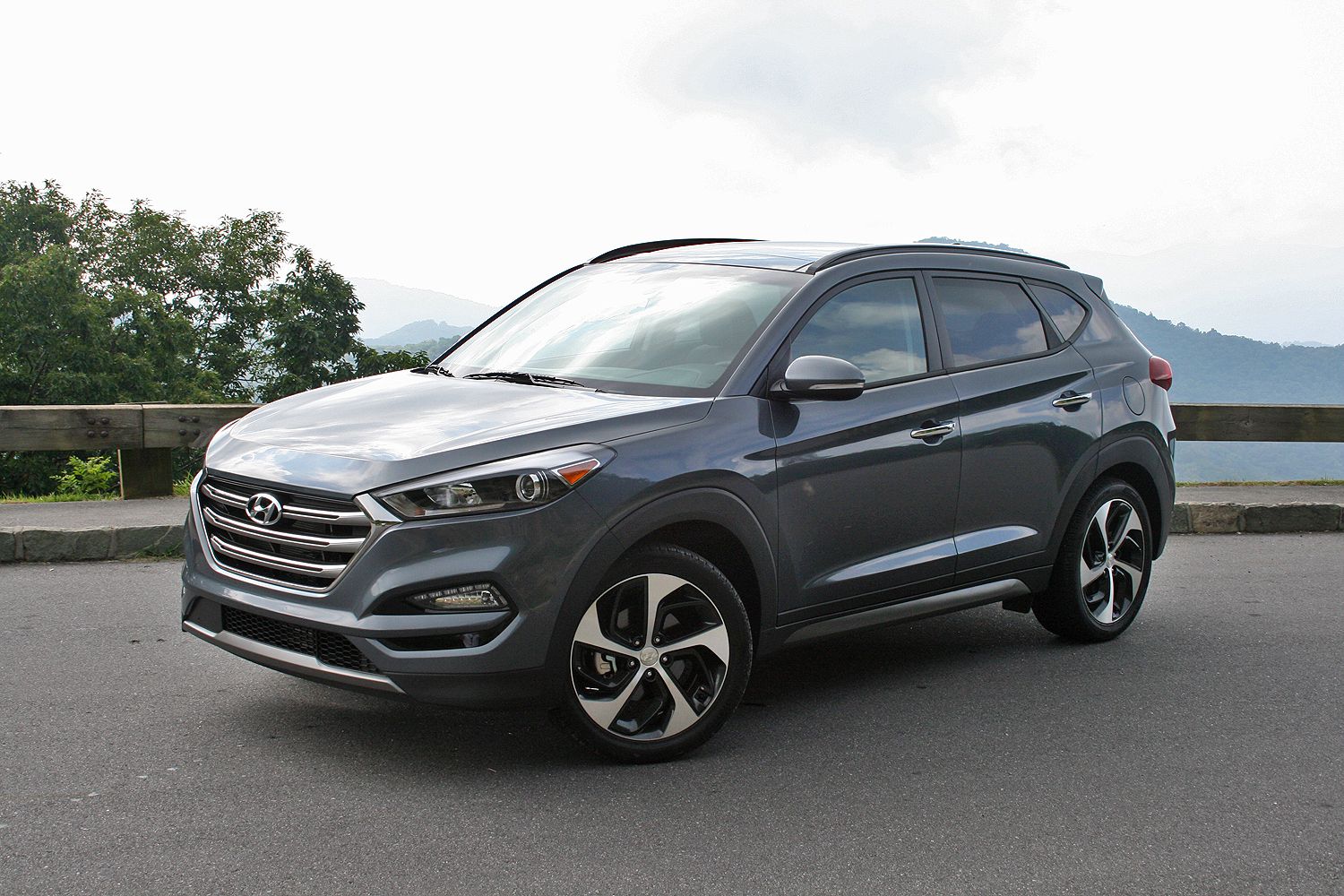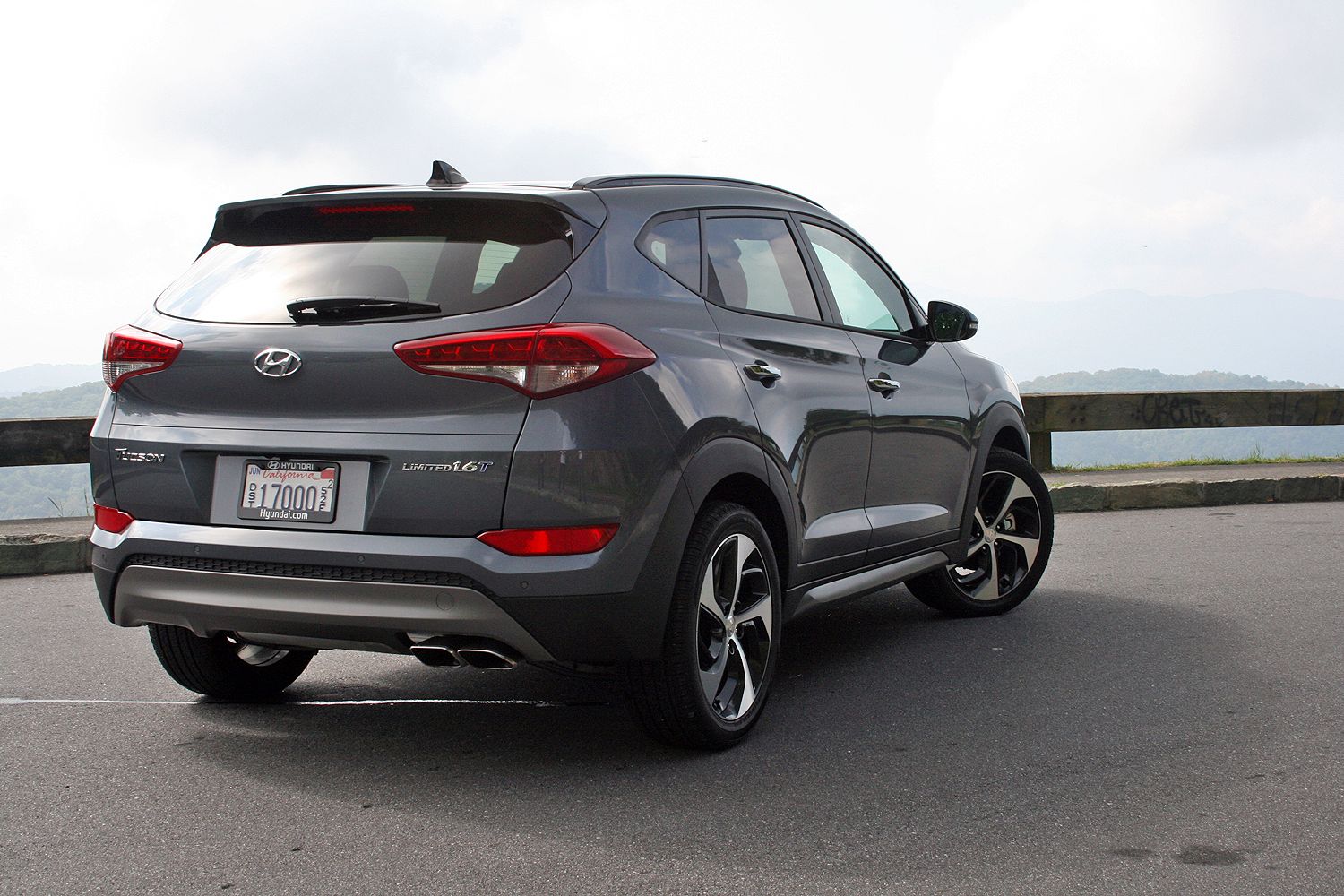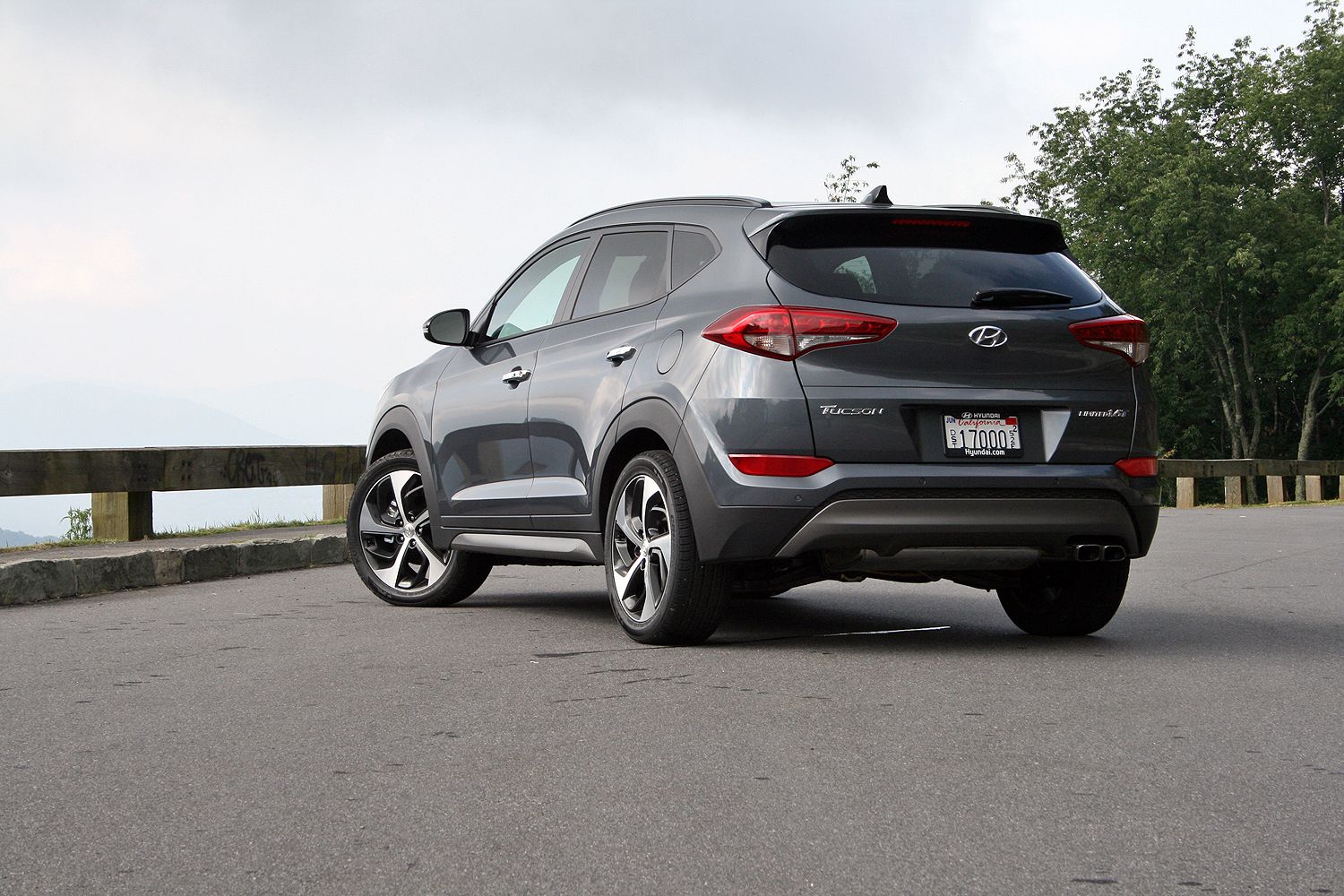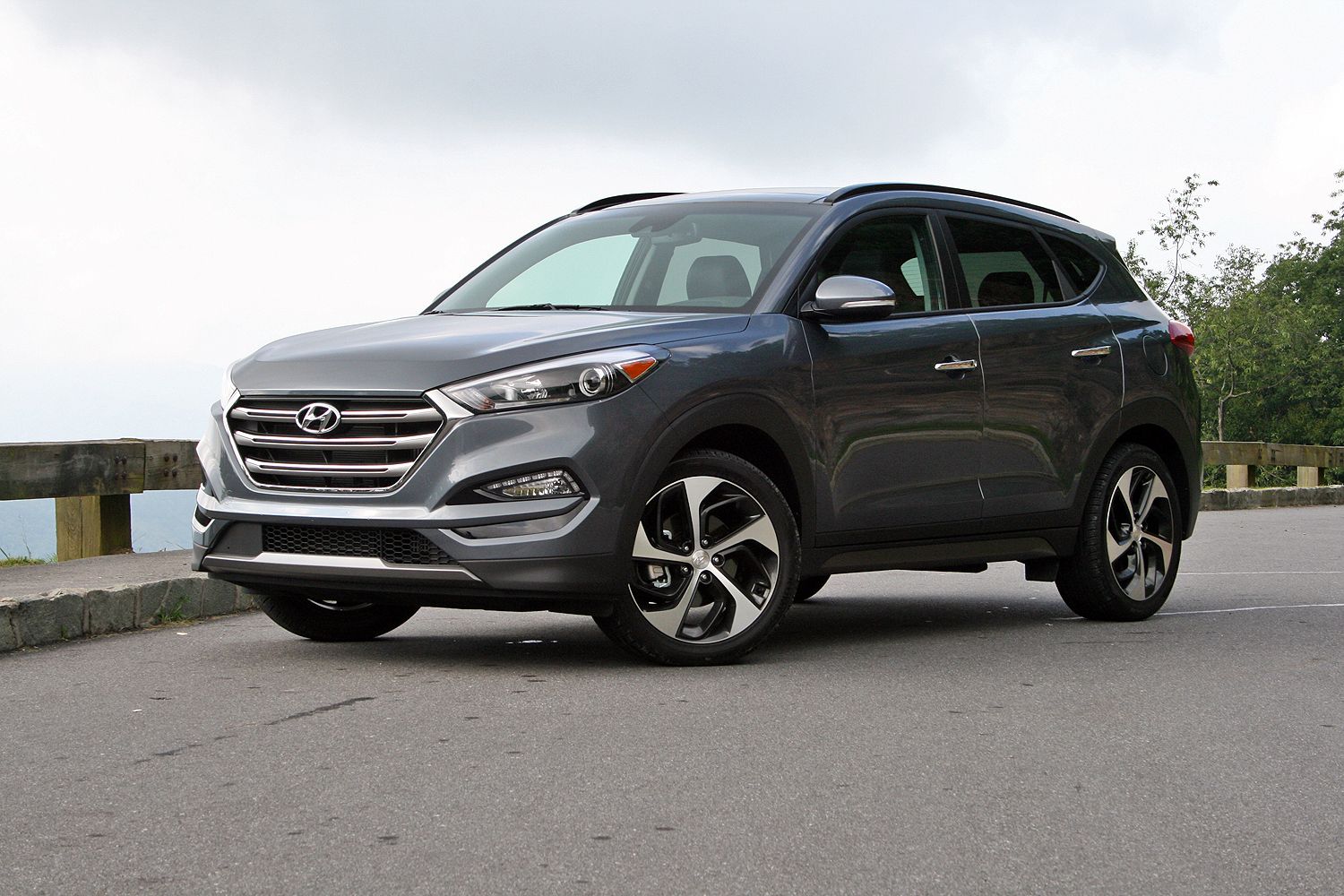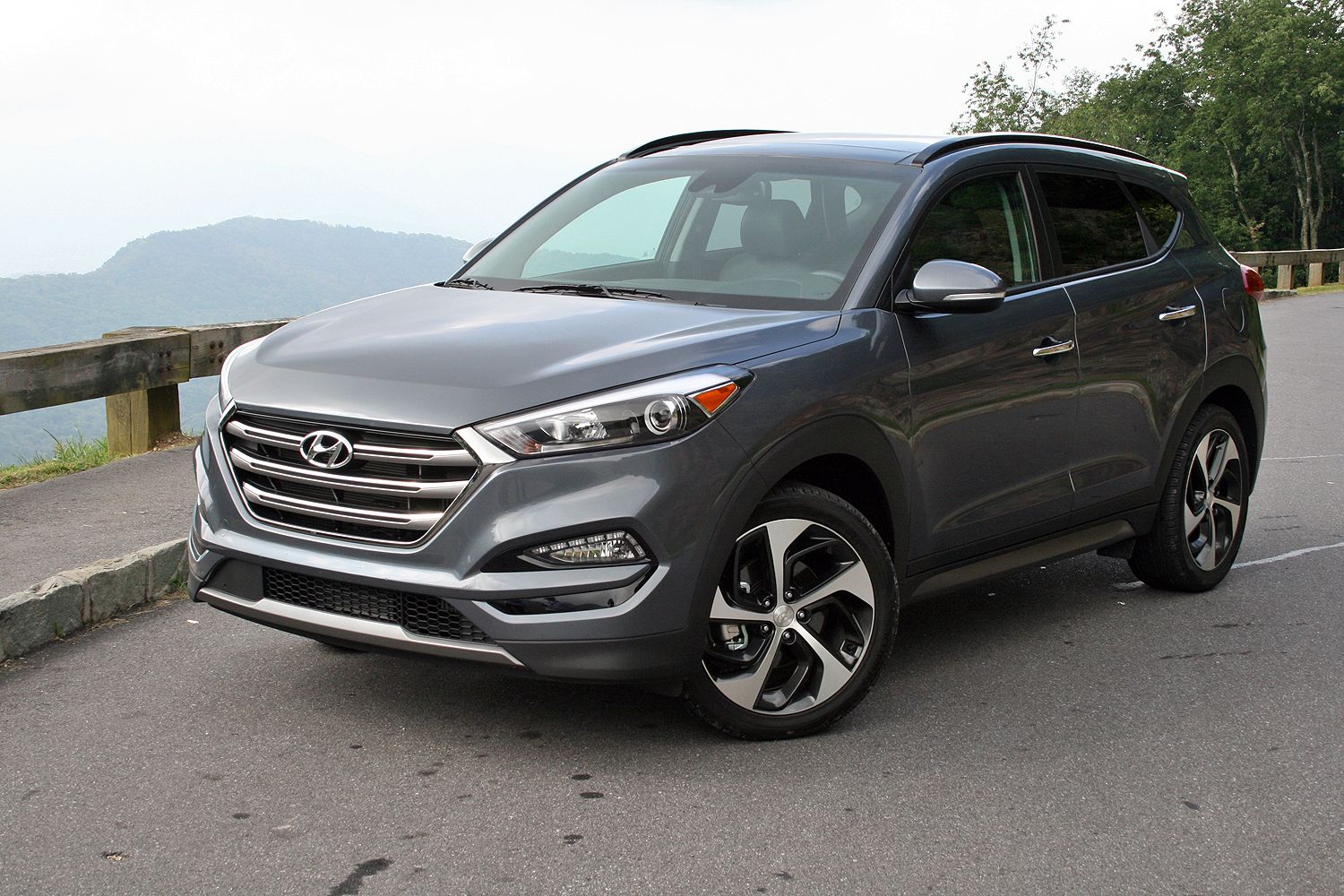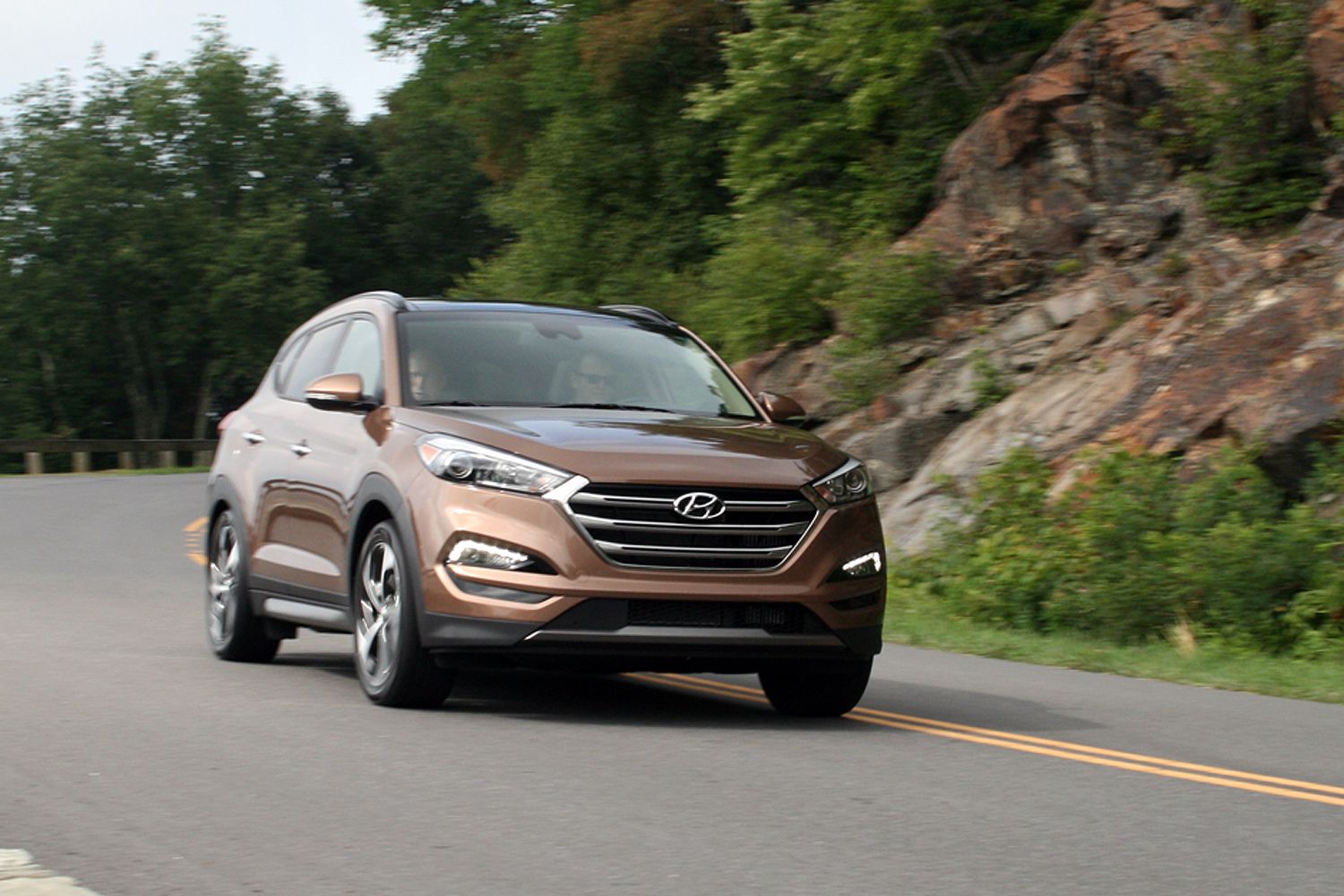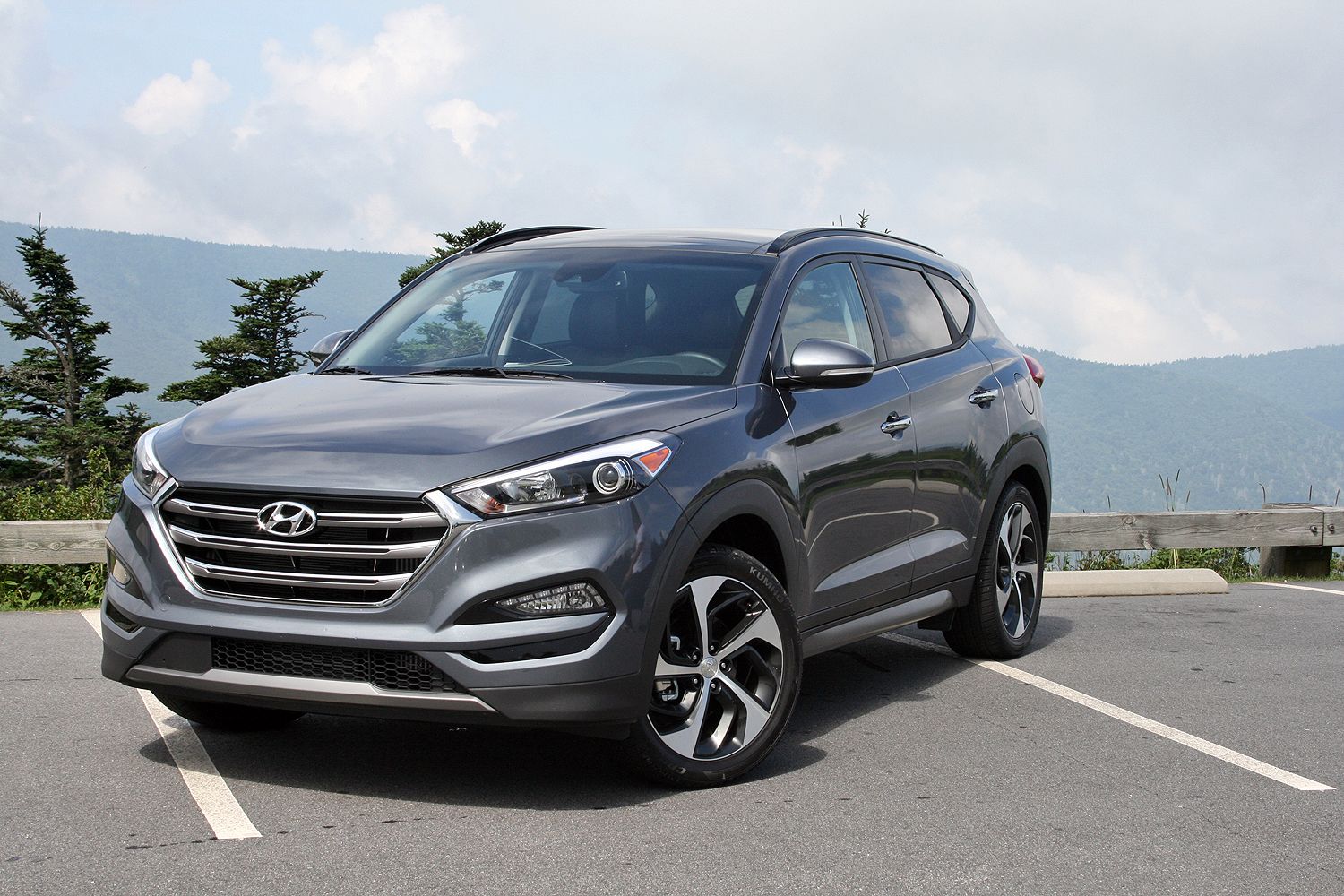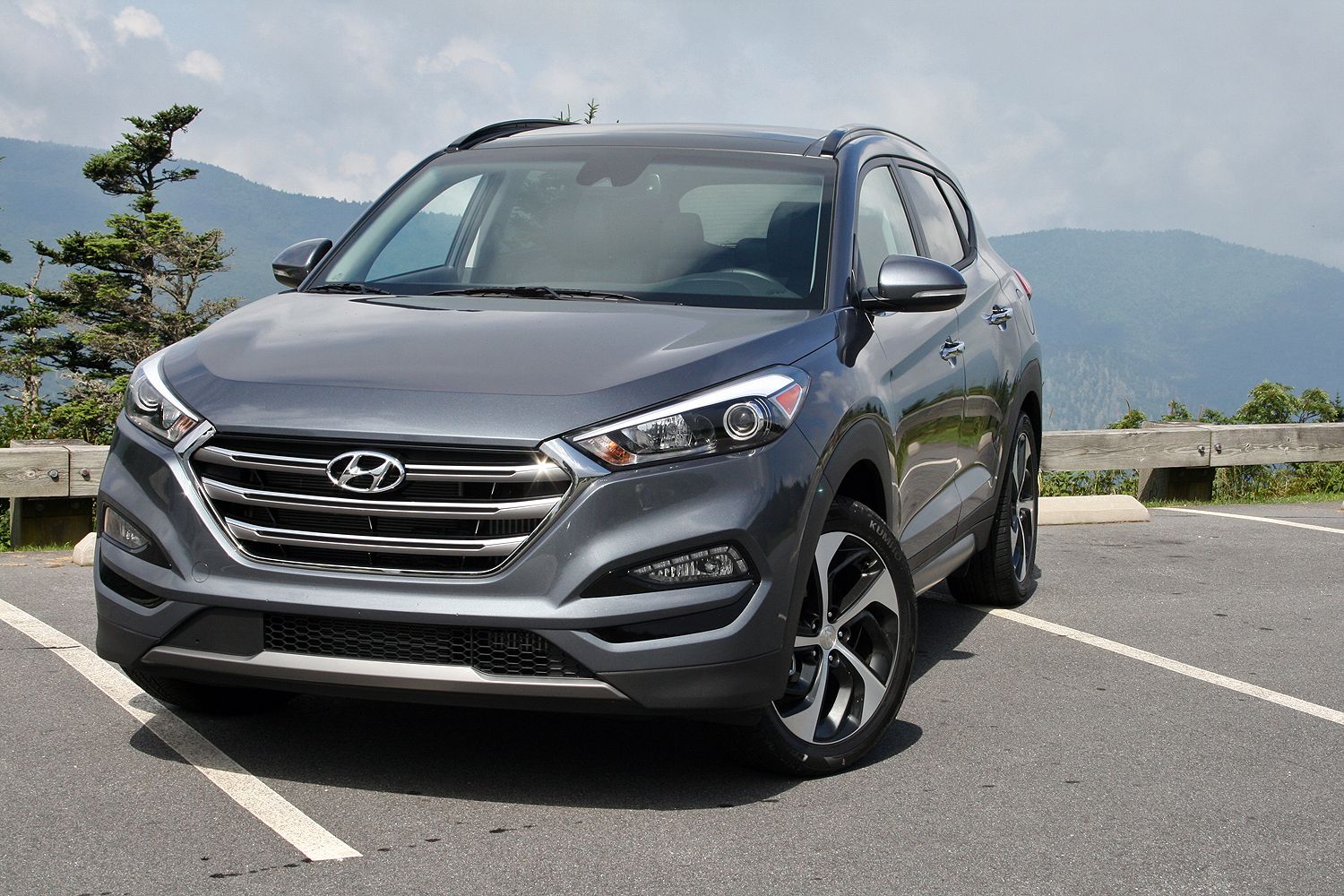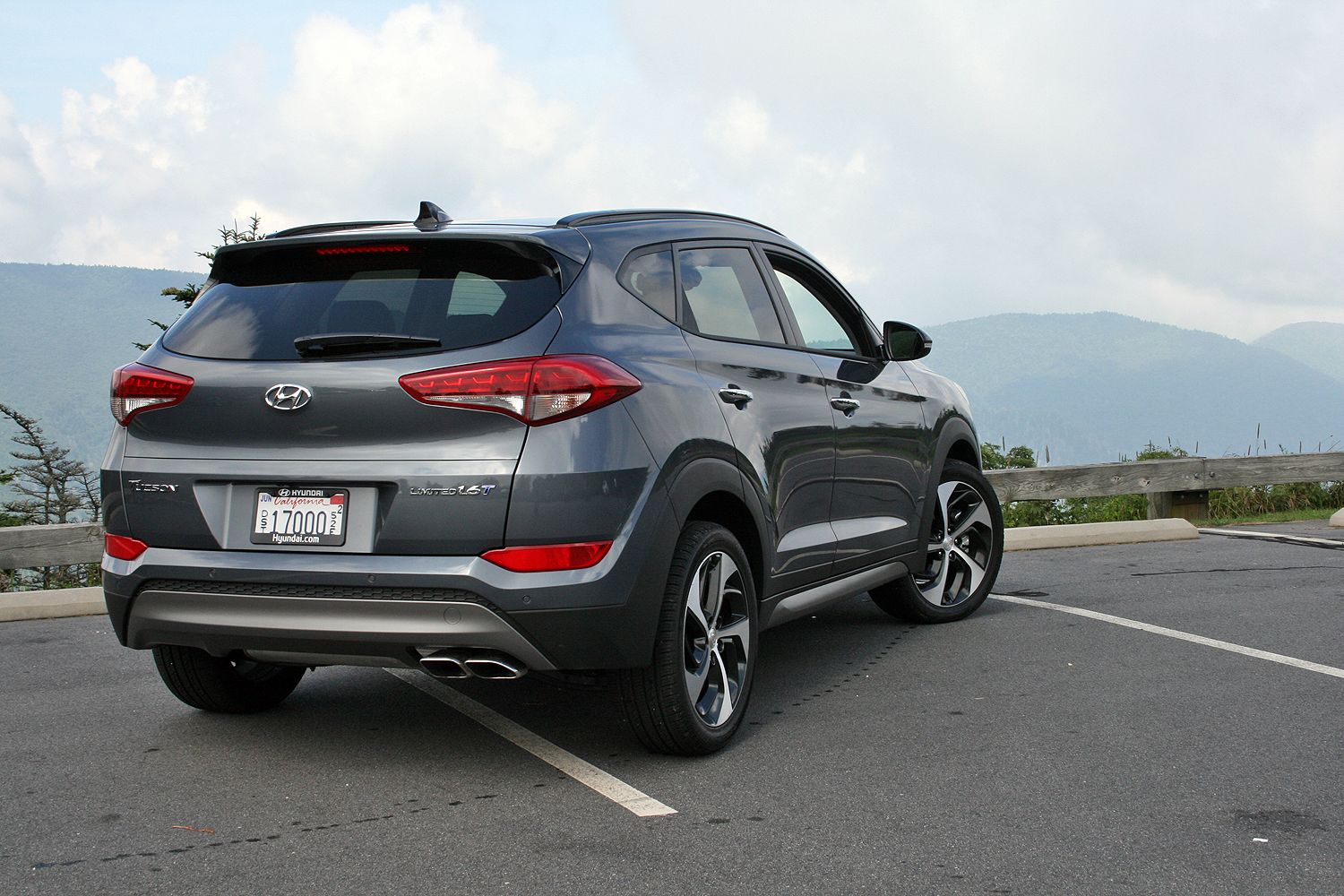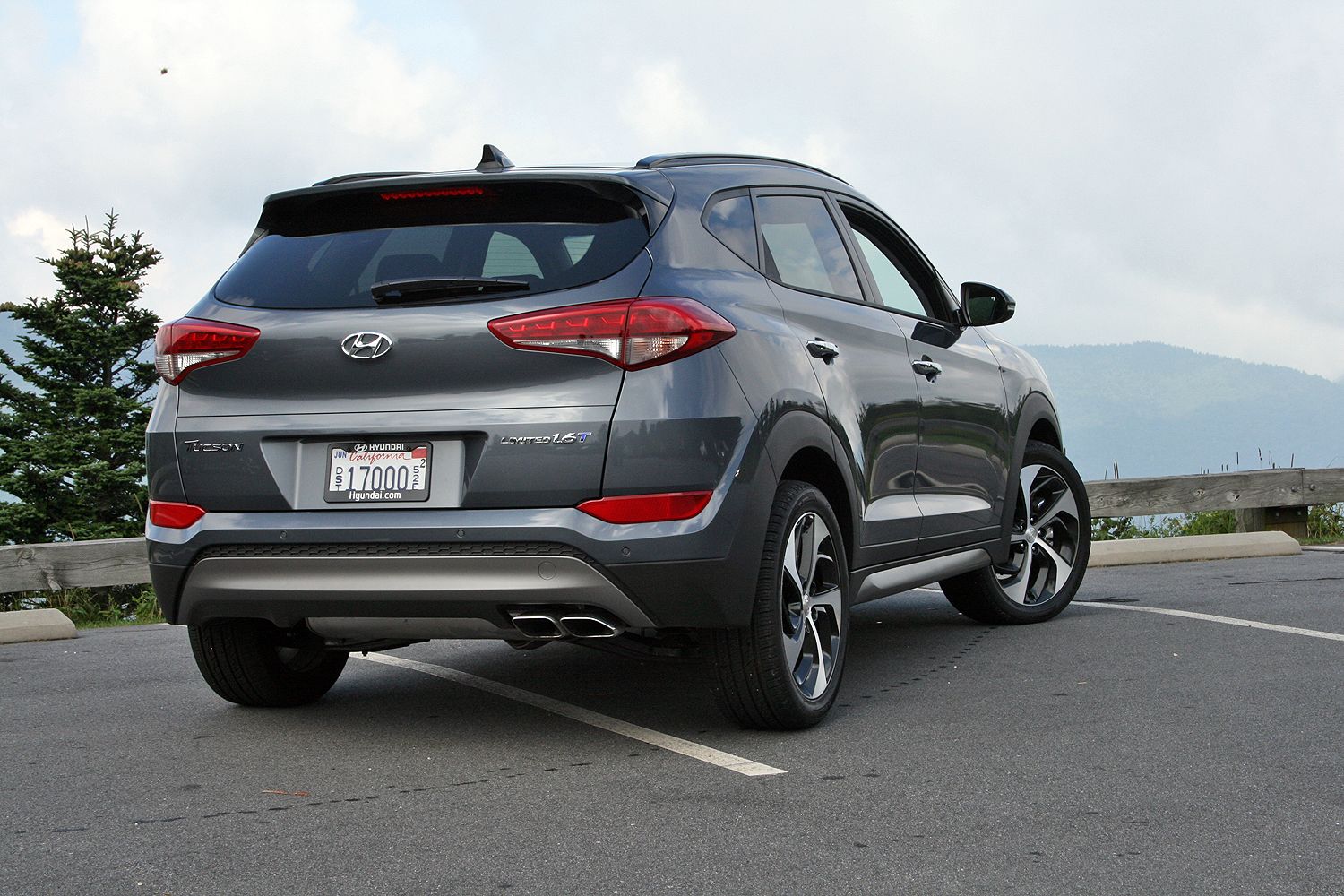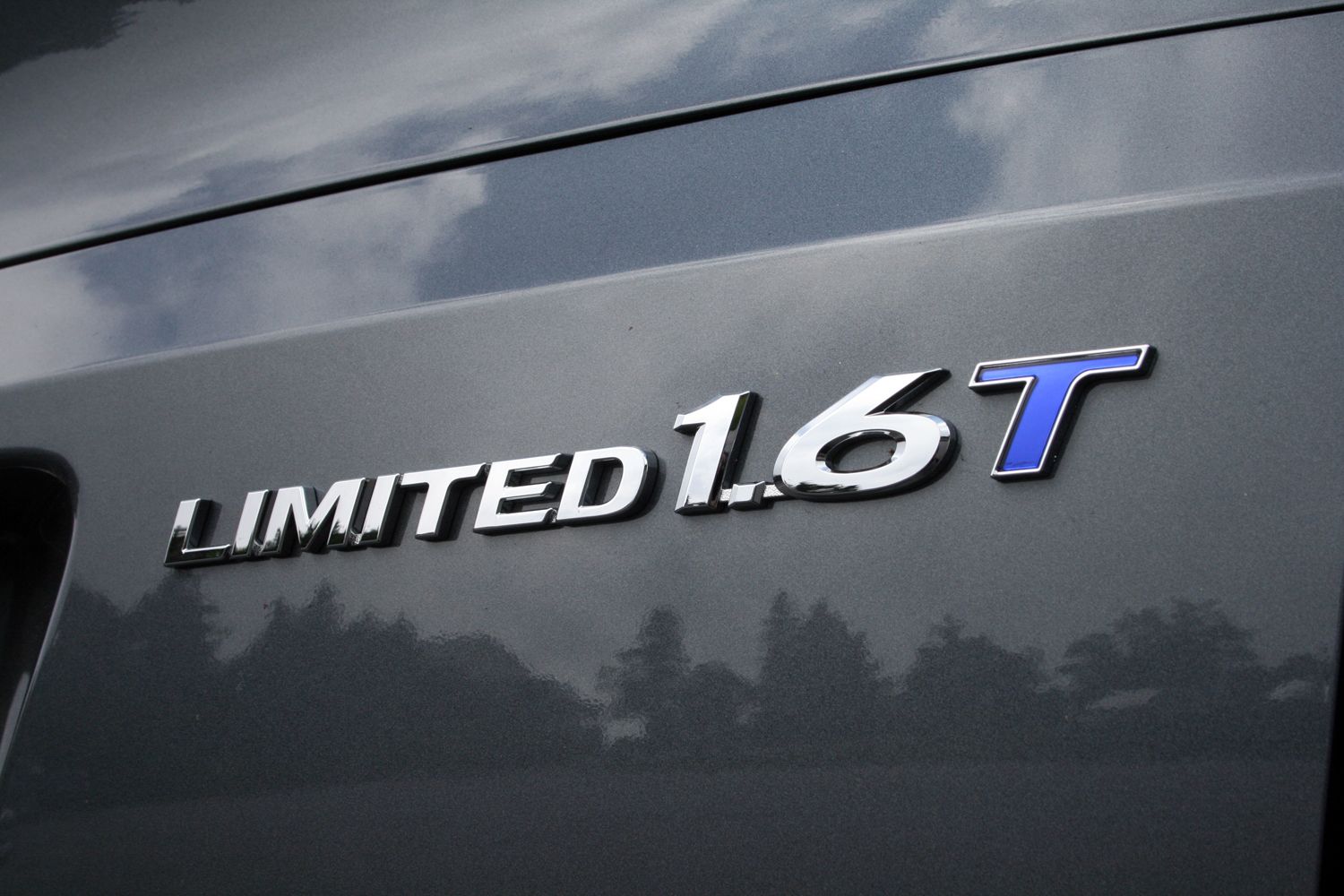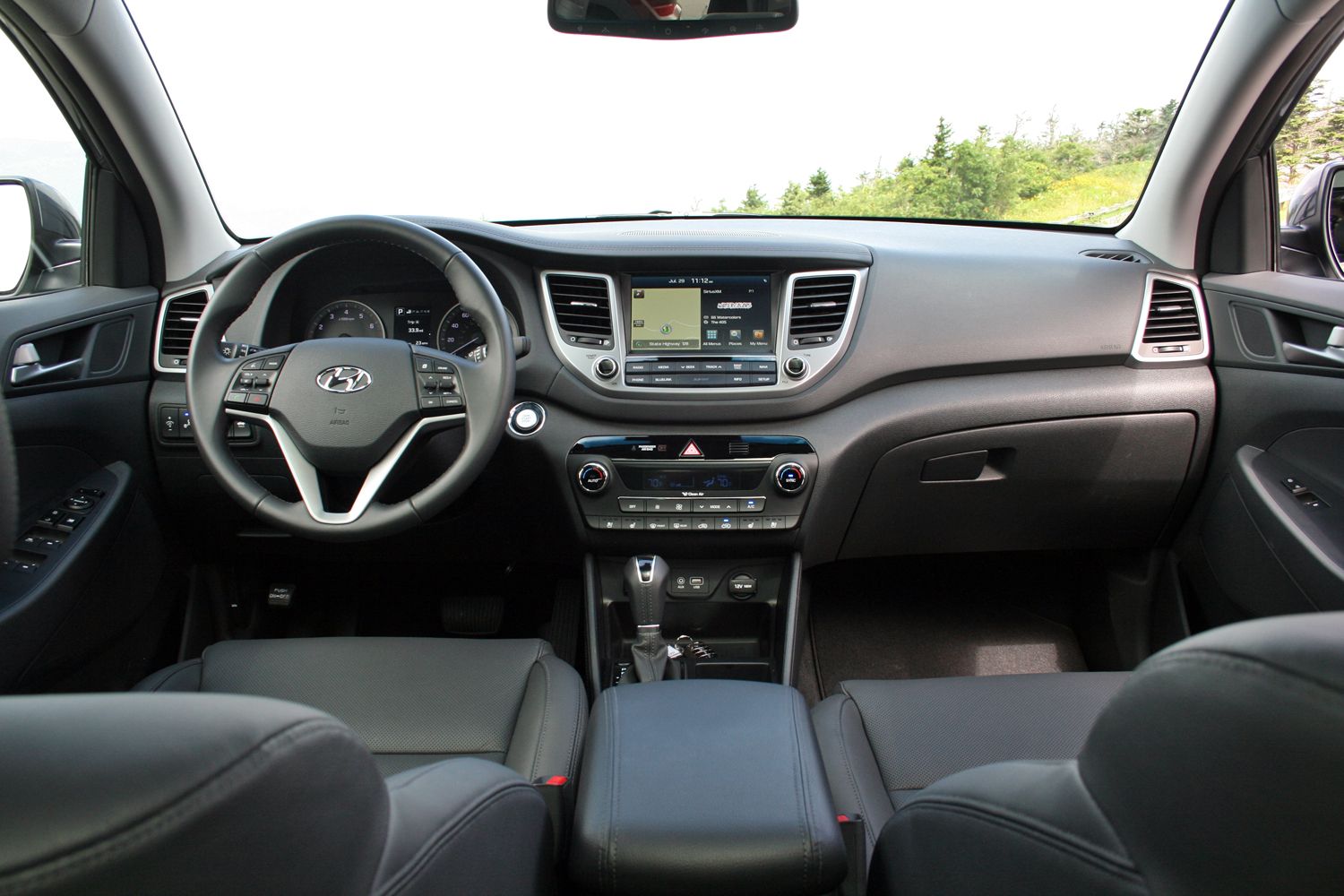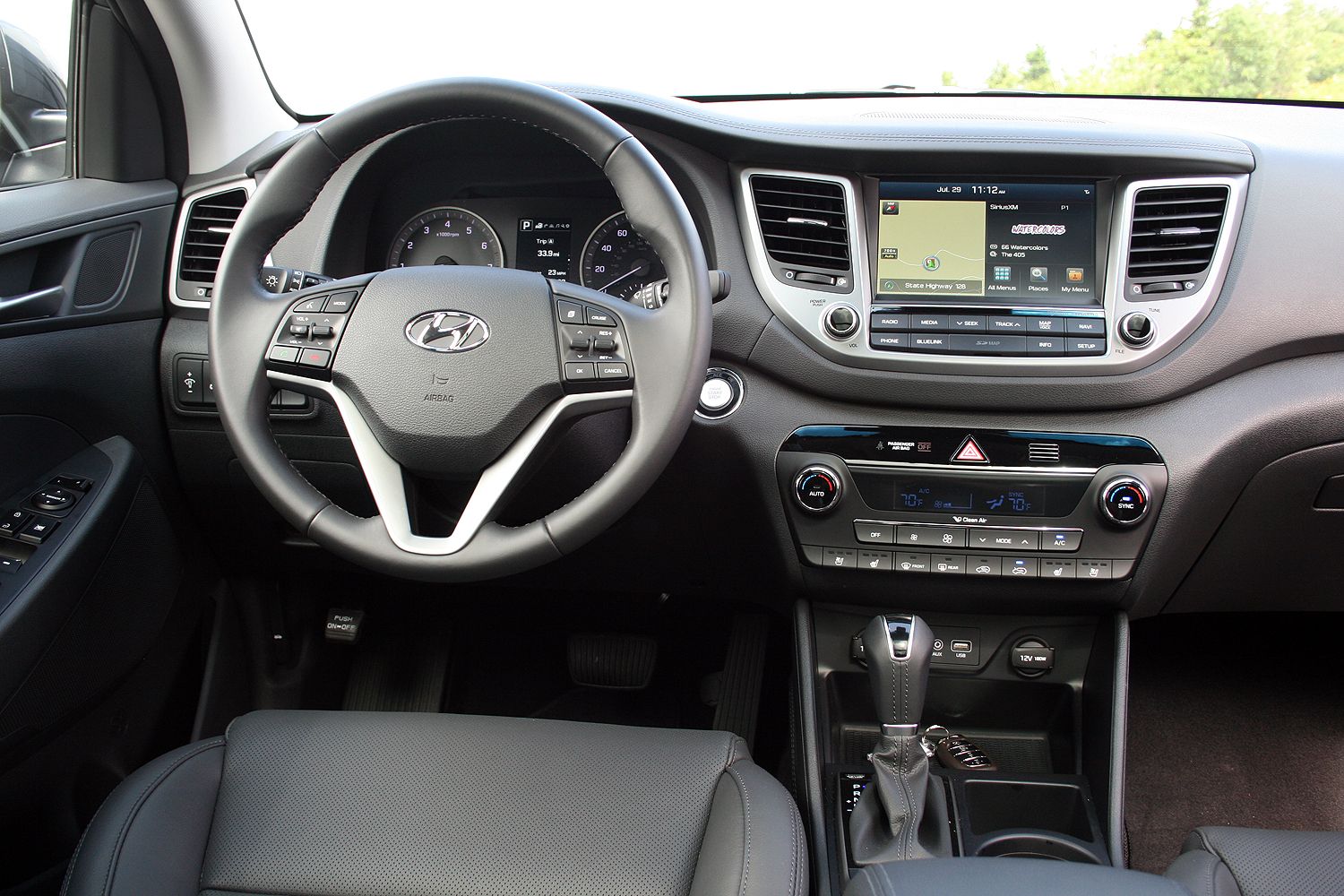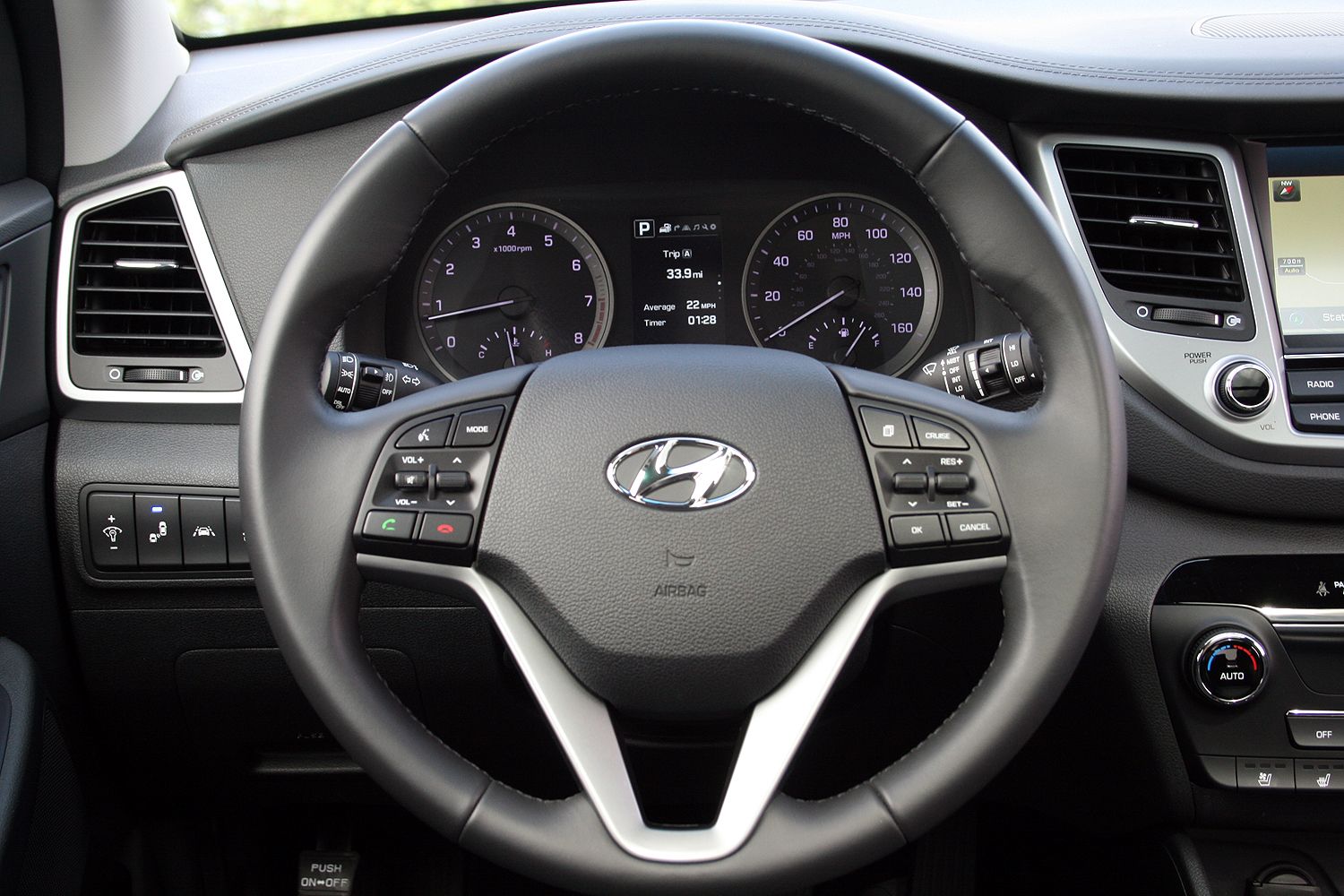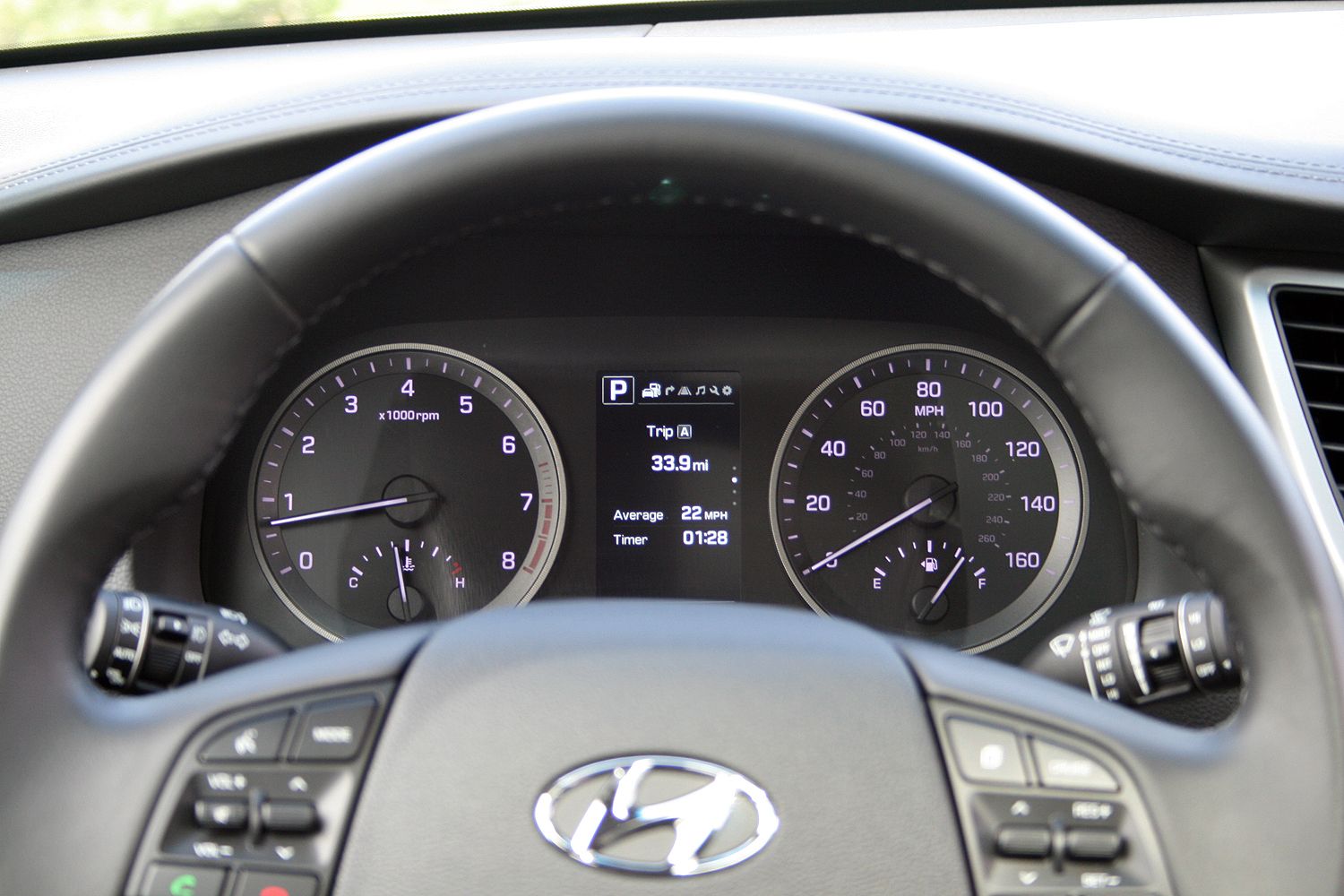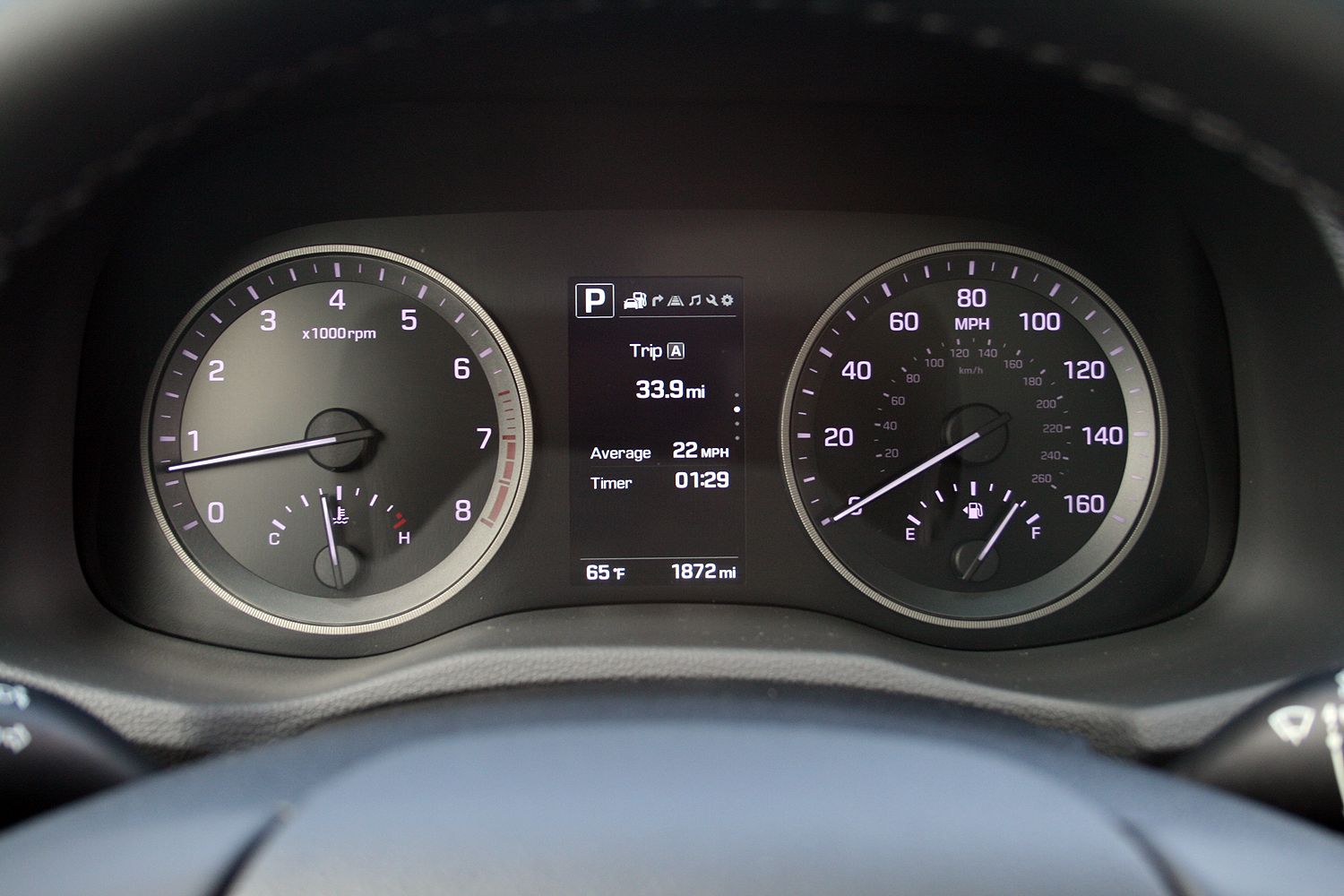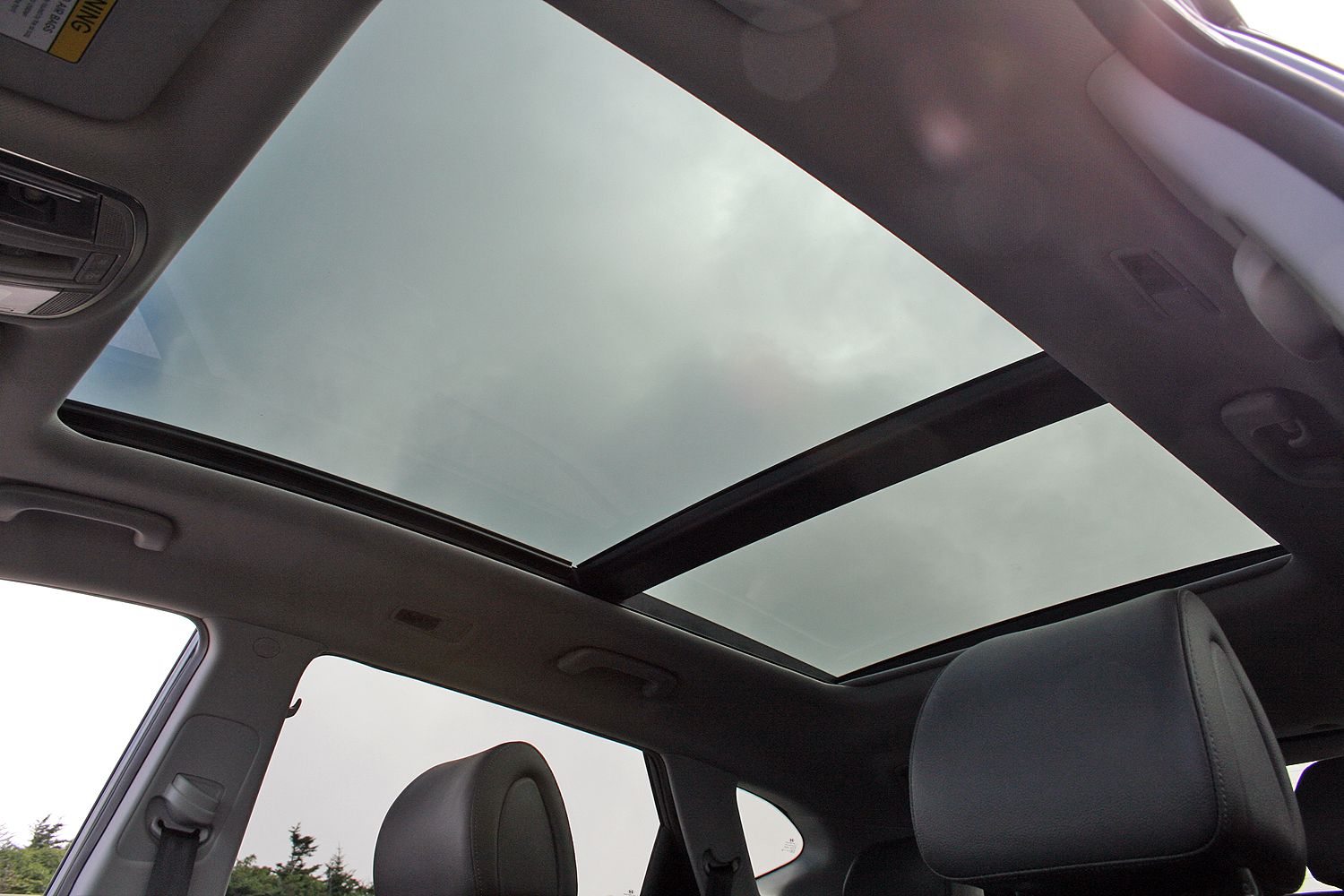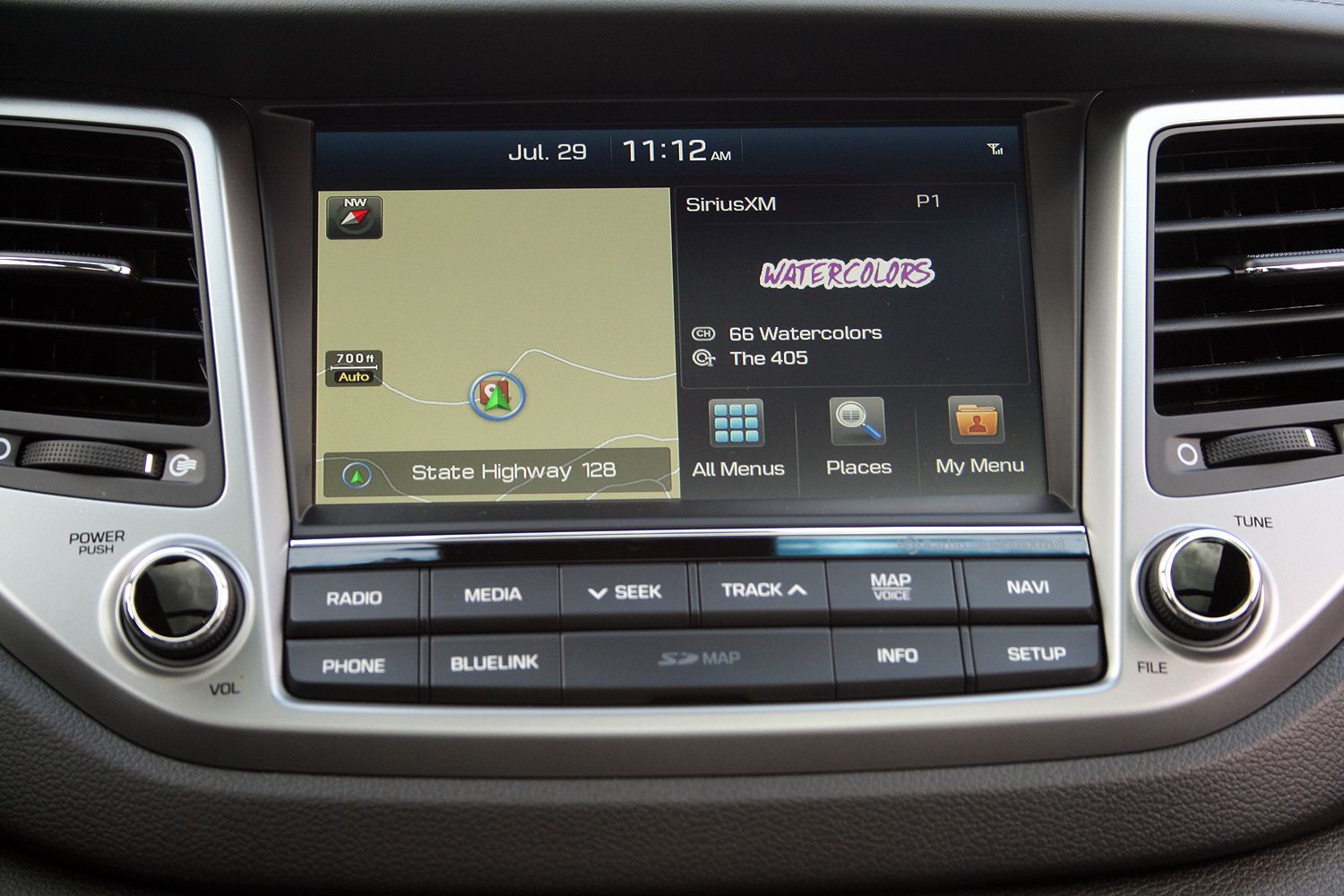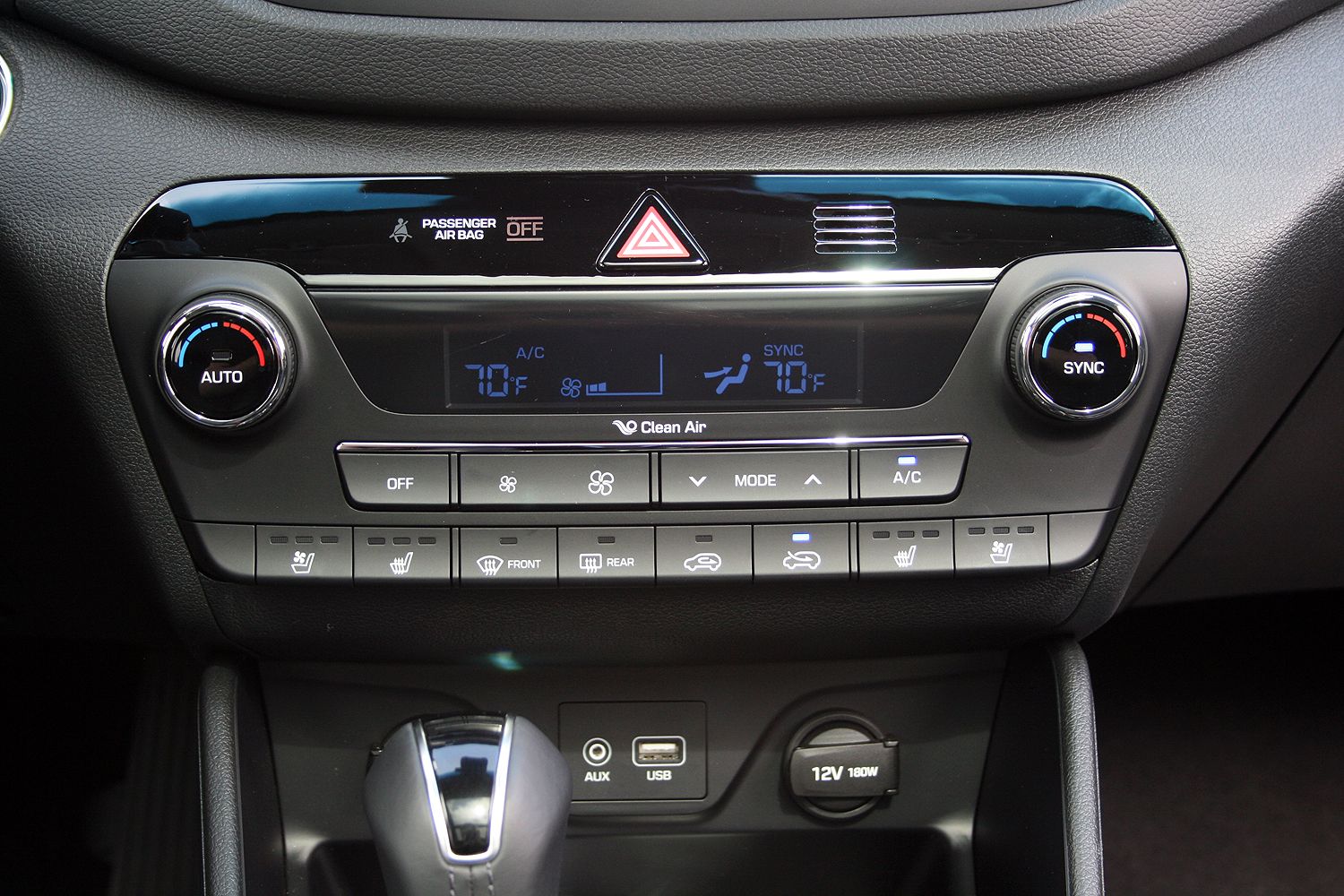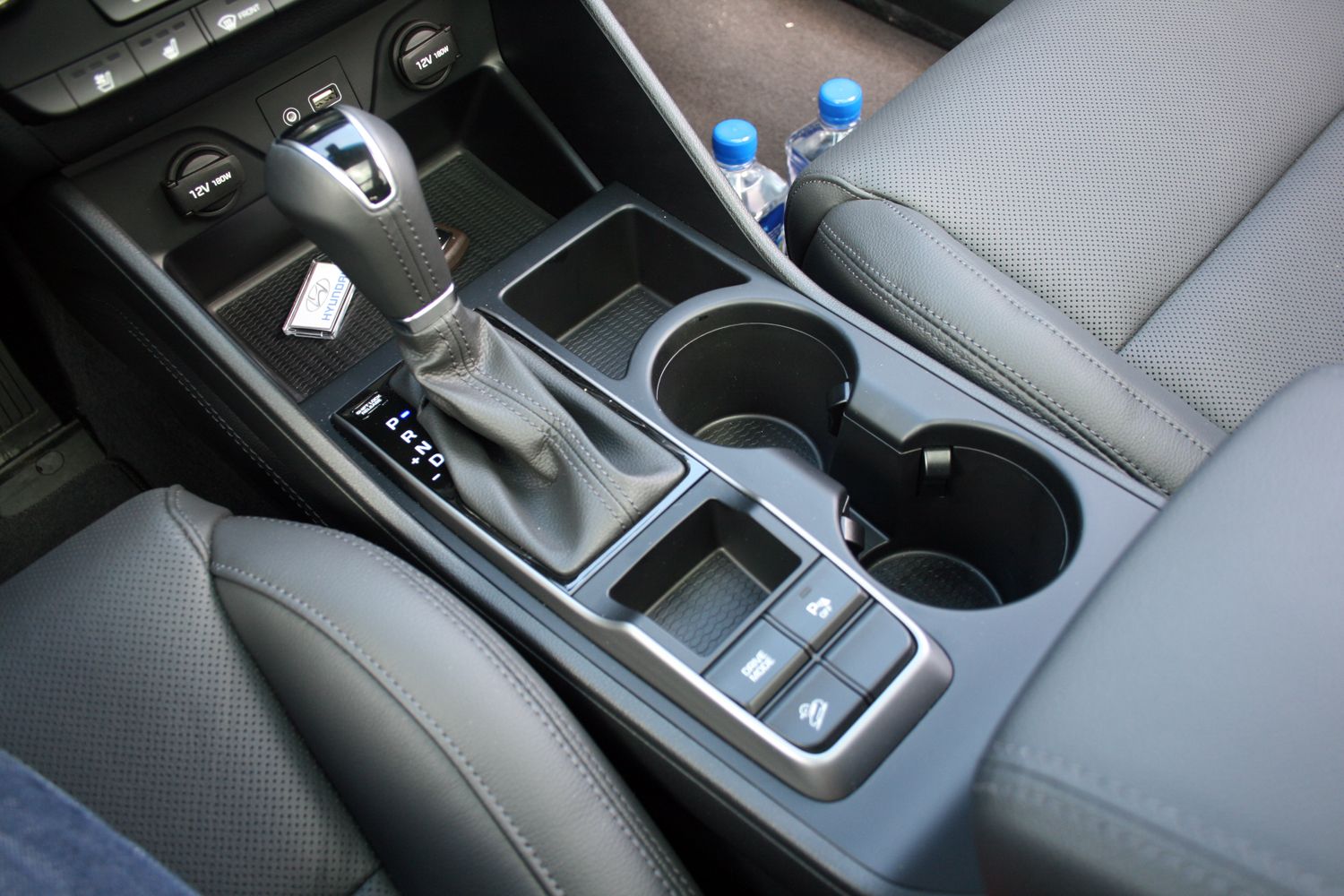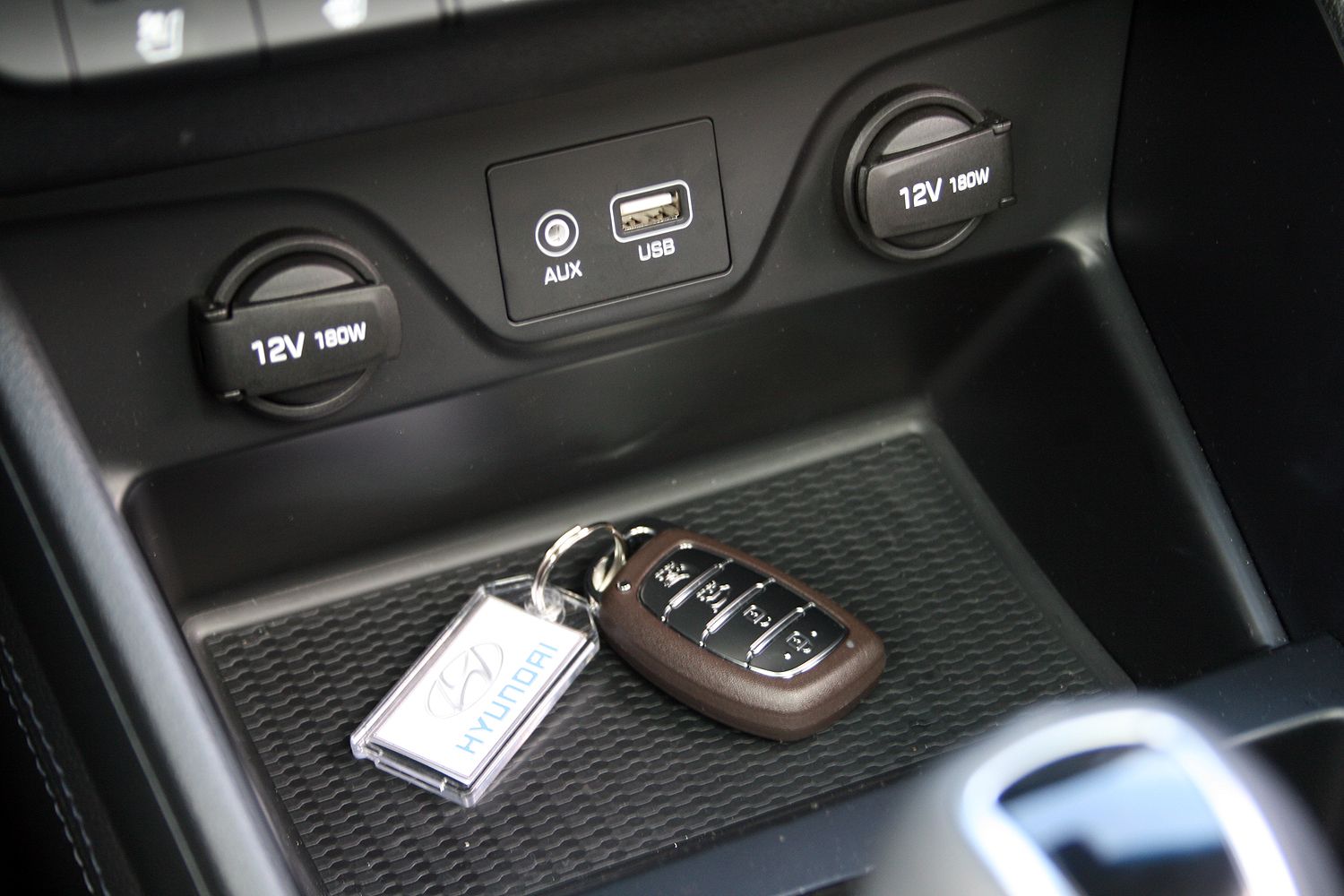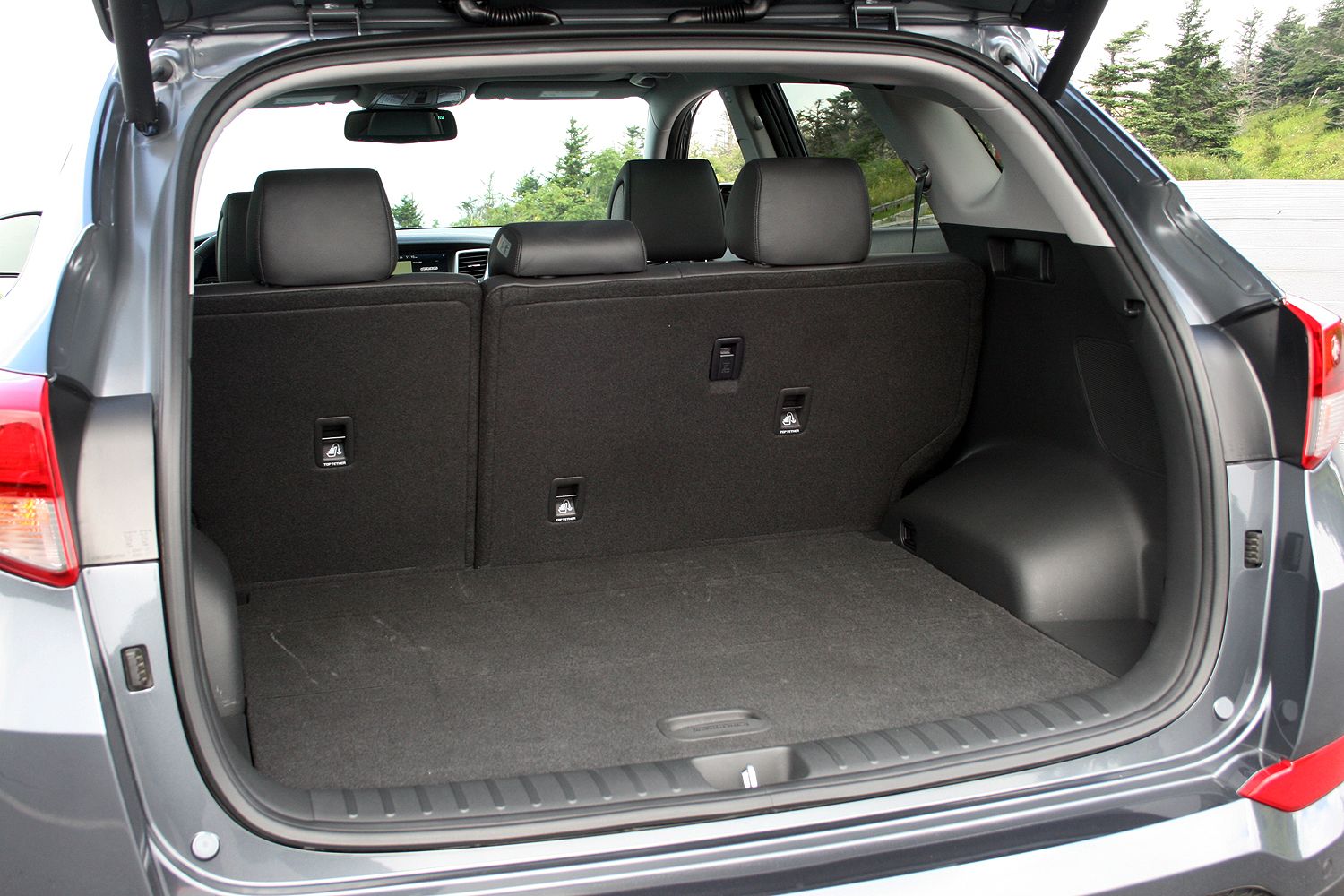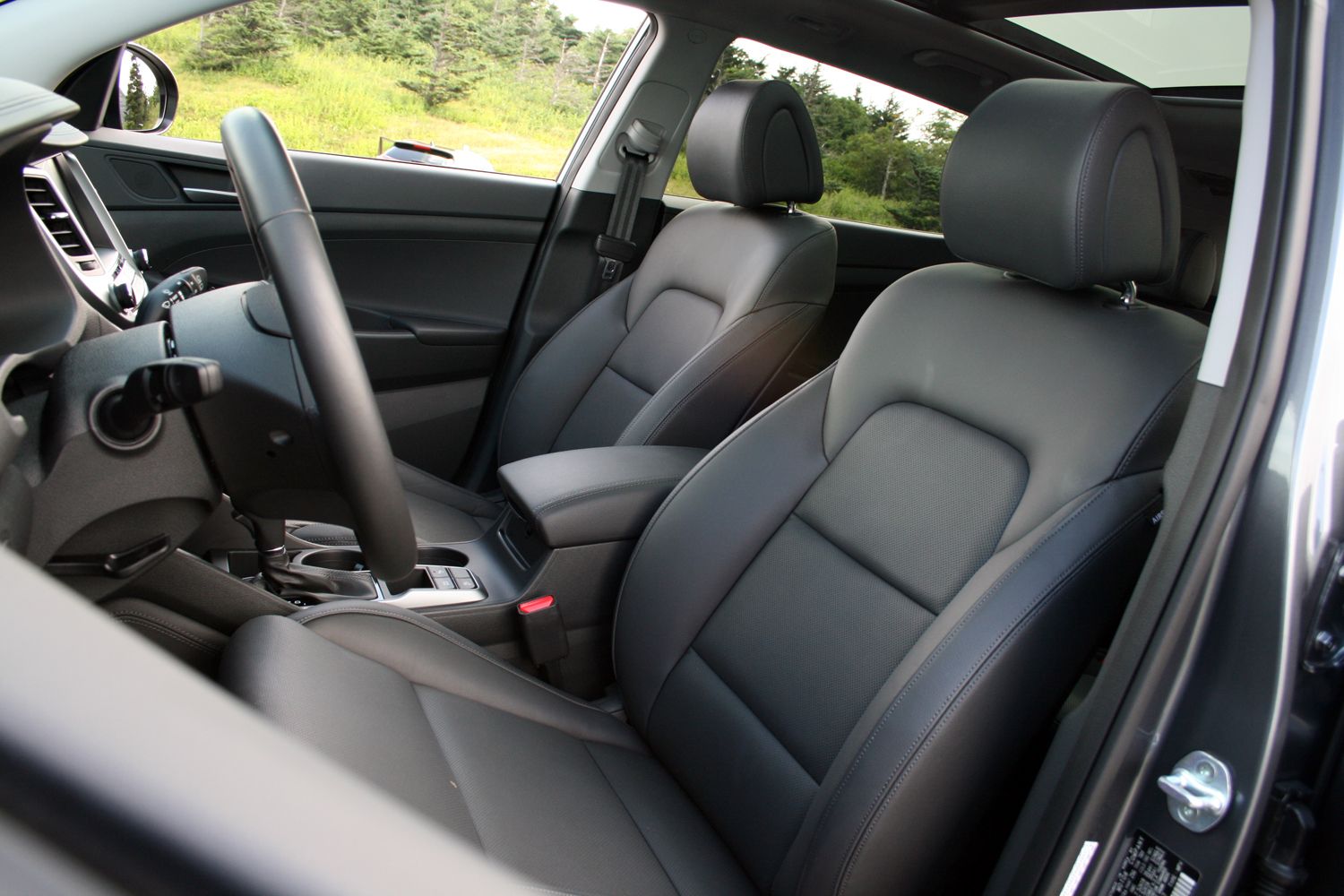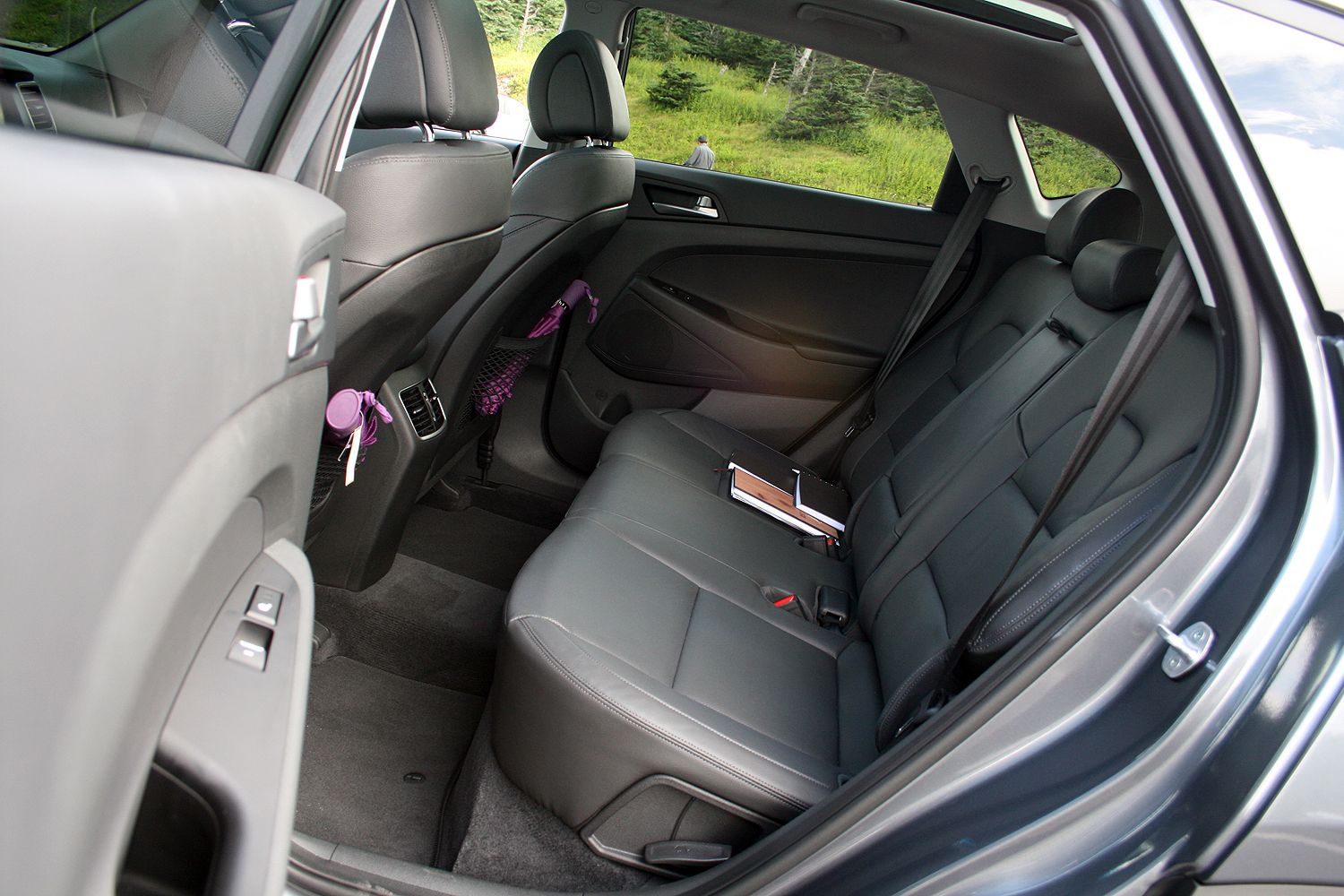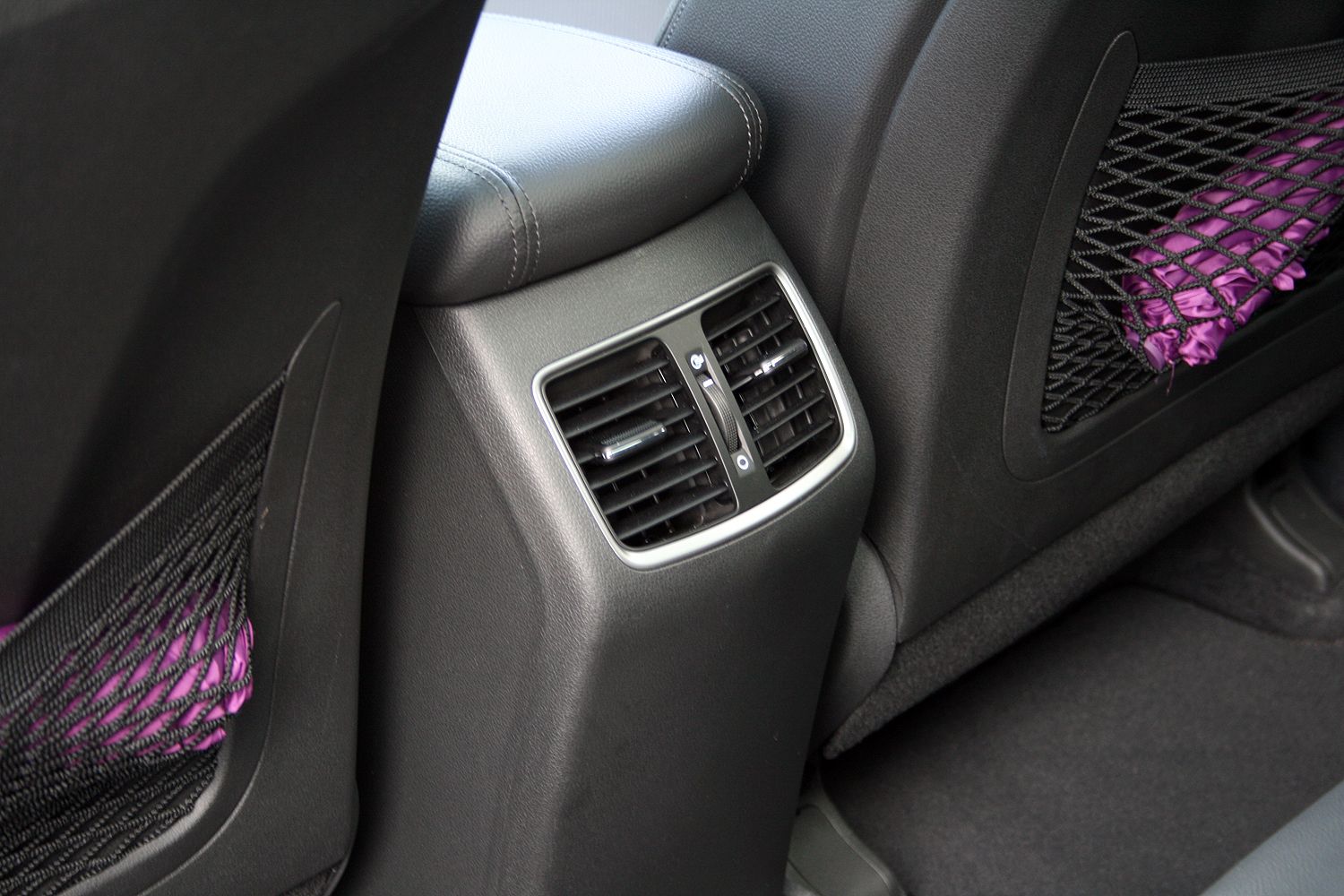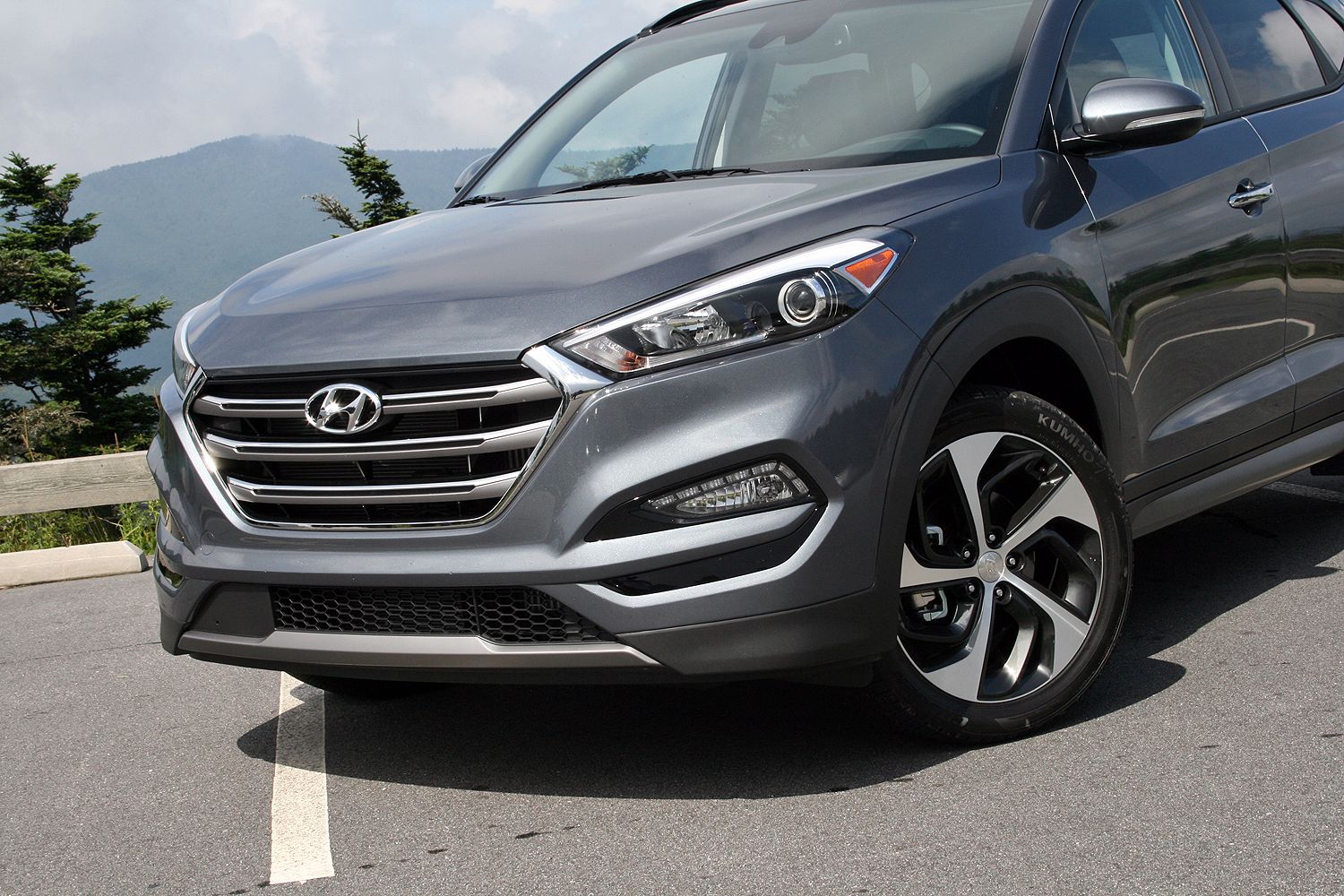The Hyundai Tucson->ke3245 may not have traditionally been anyone’s first choice in the compact->ke140 crossover->ke288 segment, having been introduced in 2005 as a budget-friendly CUV with looks only its mother could love. But things began to change when the Tucson got its first redesign in the 2010 model year. A more upscale interior, a funky exterior and powertrains fed with direct fuel injection pushed Hyundai’s->ke201 smallest crossover into a higher category level without losing its budget-minded appeal.
Now Hyundai has expanded on that premise with the all-new 2016 Hyundai Tucson. The crossover is 3 inches longer, an inch wider, and has a 1.2-inch longer wheelbase than the outgoing model, but still sits squarely in the compact crossover segment. It boasts Hyundai’s more mature six-sided grille with horizontal chrome slats, LED daytime running lights, and the automaker’s latest iterations of infotainment and connectivity features. The upper trim level Tucsons are powered by a 1.6-liter turbocharged engine derived from the 2015 Hyundai Sonata Eco. As in that application, it comes mated to a seven-speed dual clutch automatic transmission. AWD is also available.
I recently flew to the rolling hills of Asheville, North Carolina where the Blue Ridge parkway sprawls through dense forests and up to an altitude of some 6,600 feet – the highest elevation east of the Mississippi River – for a first taste of the 2016 Tucson. The design improvements are instantly recognizable, and the interior doesn’t take any longer to show off its upgraded materials, design, and new technology.
Continue reading for my full review of the latest Tucson.
2016 Hyundai Tucson - First Drive
- Make: Array
- Model: 2016 Hyundai Tucson - First Drive
- Engine/Motor: inline-4
- Horsepower: 175 @ 5500
- Torque: 195 @ 1500
- Transmission: Seven-Speed Dual Clutch
- [do not use] Vehicle Model: Array
Walk-Around
Exterior
The initial impression of the Tucson is of its much more grown-up looks. The six-sided grille dressed in chrome is flanked by LED daytime running lights, fog lights, and on the range-topping Limited trim, full LED headlights.
The little CUV gets a shot of testosterone, thanks to the black plastic fender flairs that arch high over the optional 19-inch wheels -- 17-inch alloys come standard on the base SE. Above the arches is a rather handsome accent line that runs from the A-pillar to the taillights.
A sloping greenhouse peaks in height above the front row and falls toward the D-pillar. Honest roof rails offer the ability to carry bikes or kayaks up top. Between the rails is an optional panoramic sunroof that greatly opens up the cabin. Its large opening panel runs nearly into the second row.
The heavy styling continues around back. LED taillights on the Limited trim level gives the CUV a more upscale look while lower bright work makes the Tucson visually taller. A twin-tipped chrome exhaust pipe sticks out from below the right side. Up top, the roof slops nicely into the rear glass and features a spoiler Hyundai says helps increase aerodynamic efficiency. A classy shark-fin antenna caps off the Tucson’s new, more premium appearance.
All told, the exterior works well as a design, with all the molding and body lines working together to make a single style. Looks are certainly subjective, but to my eye, the 2016 Tucson looks far more attractive and respectable than it ever has.
Interior
Not only does the Tucson incorporate more of Hyundai’s current exterior design styling, it also brings the interior up to date with the automaker’s more current offerings. The Tucson’s interior takes after the well-design Sonata,->ke1859 using many of the same materials and controls. It’s also here where the differences in trim levels become very apparent.
The previous Tucson had only three trims to choose from: GLS, SE, and Limited. Now the Tucson has dropped the base GLS, added another trim level below the Limited, and introduced the Eco trim. For 2016, the CUV is offered as an SE, Eco, Sport, or Limited.
Lower models feature full-length plastic dashboards that are mildly soft-touch. The Limited gets a classy leather-like covering with French stitching along the driver and center sections of the dash. Most other materials are soft-touch, save for the horizontal piece between the glove box and HVAC controls, and the upper dash section. It is noticeably out of place. The padded door panels and center console further contrast to the low-budget piece.
Grab the leather-wrapped steering wheel and the concerns of quality go away. It’s a well-designed wheel with no rough edges on the plastic parts (as sometimes found at this price point) and the controls for the center TFT information display, radio settings, and cruise control are intuitive. Speaking of displays, the Tucson comes with the option for Hyundai’s new 8-inch infotainment unit with navigation, SiriusXM, Yelp, Travel Link, and Tune Start – the feature that plays a current song from the beginning when tuning to a SiriusXM channel. The system also supports Google search.
Limited models go the extra step in keeping occupants comfortable. Dual zone climate controls, heated and cooled front seats, rear-seat air vents, and heated outboard rear seats add that extra touch. All models enjoy reclining rear seats. The function is easily executed with a well-placed lever and offers a generous amount of lean. A center armrest gives elbows a place to rest. The seats also offer a 60/40 folding for increasing cargo room.
In the cargo area, designers included a multi-level floor panel. Leave it in the upper position for a flat load floor or put it in the lowered position for an extra two inches of space. Below the floor resides a compact spare tire and all the ancillary equipment for roadside situations. Getting into the rear cargo area is easy thanks to the optional hands-free smart liftgate. Just stand behind the car for three seconds with the key in your pocket, and the liftgate rises up. No kicking your feet involved.
My only major complaint about the Tucson’s redesigned interior is the lack of USB ports. There is only one – located in the center console. That means only one of the five passengers can charge a device at a time.
Safety Equipment
The 2016 Tucson has a ton of active and passive safety equipment, including Lane Departure Warning, Blind Spot Detection, Lane Change Assist, Rear Cross-traffic Alert, and Hyundai’s first Automatic Emergency Braking with pedestrian detection.
The emergency braking system uses a windshield-mounted camera to detect objects in front of the car and warns the driver of impending danger. If the driver takes no action, the system then automatically applies the brakes, bringing the Tucson to a complete stop. Only the 2015 Honda CR-V and 2016 Mazda CX-5 offer this type of system.
Of course the standard battery of airbags are present, including driver and front passenger airbags and full-length side-curtain airbags.
Beyond airbags and electronic equipment, Hyundai engineers also concentrated on the structural components of the Tucson. The A-pillars tie into the front structural frame at a straighter angle, adding additional frontal impact strength. The same can be said about the D-pillars.
The rear roof crossmember ties in with the pillar to help give the Tucson’s roof better rollover ratings. More strengthening went into the floor pan, helping the CUV become more ridged than the previous generation. Not only does that help in safety, it also increases driving and handling performance. Finally, the door structures around the cabin are hot-stamped and provide better side-impact protection.
Powertrain
Improvements continue under the hood as well. Like the generation past, the Tucson is offered with two engine options, though one of those has changed. The 2016 Tucson drops the 2.4-liter four-cylinder in favor of Hyundai’s 1.6-liter turbocharged four-cylinder. Previously seen in the Sonata Eco, the direct-injected engine kicks out 175 horsepower at 5,500 rpm and 195 pound-feet of torque between 1,500 and 4,500 rpm.
The 1.6-liter comes mated to the same seven-speed dual clutch automatic transmission in the Sonata Eco and provides quick shifts, but is tuned for fuel economy more than sportiness. Despite this, the turbocharged engine provides plenty of power down low for moving the 3,369- to 3,710-pound CUV.
The Tucson’s AWD system is a FWD-biased system that routes power to the wheels with the most traction. During normal conditions, the AWD sends the majority of power to the front wheels. For severe conditions or light off-roading, a console-mounted button allows the driver to lock in a 50/50 torque split between the front and rear axles.
The 1.6-liter is the volume engine and is included in the Eco, Sport, and Limited trims. The 2.0-liter is relegated to the base SE trim level. The 2.0-liter isn’t necessarily the penalty box, however, as it still produces 164 horsepower at 6,200 rpm and 151 pound-feet of toque at 4,000. Backing the engine is a conventional six-speed automatic transmission.
Fuel economy is another area in where the 1.6-liter shines. Both the Sport and Limited trims carry EPA estimates of 25 mpg city, 30 mpg highway and 27 mpg combined in the FWD configuration. Opt for AWD and the mileage drops slightly to 24, 28, and 26 respectively. The Eco trim lives up to its name by earning EPA estimates of 26,33, and 29 mpg with FWD and 25, 31, and 27 mpg in AWD.
The older 2.0-liter gets 23 mpg city, 31 mpg highway, and 26 mpg combine with FWD and 21, 26, and 23 mpg in AWD. All Tucson models come with a 16.4-gallon fuel tank and sip regular unleaded.
Driving Impressions
It doesn’t take long behind the wheel of the all-new Tucson to realize how far this crossover has come. Improvements to the suspension system and electronic steering rack, and the peppy 1.6-liter bring a newfound pleasure to its driving feel. The larger 19-inch wheels on the Sport and Limited trims further help the Tucson’s handling feel.
Starting with the steering, its feel is best described as light, especially in comparison to many of today’s heavy-handed vehicles. On-center feel is free of slack and turn-in happens nice and smooth. The small turning radius will remind you of this crossover’s class size, though its interior tries to convince you otherwise. Throttle response is good and is happily absent of tip-in. The brakes are just as smooth, providing a linear pedal feel and confident stopping power.
Body roll is surprisingly well managed and turns are taken with surprising confidence. Much of that can likely be attributed to Hyundai’s torque vectoring system on the Tucson AWD. The system sends traction where its needed and applies braking force to the inside rear wheel during hard corners to help pull the vehicle around the turn.
The Tucson offers three driving modes: Eco, Normal, and Sport. The differences in each mode are apparent and most noticeable in the steering feel, throttle response and transmission shift points.
Outward visibility is very good with its tall windows, sloping hood, and large side mirrors. Even the view rearward is good, thanks to a decent-sized mirror and rear glass. When in reverse, the standard backup camera offers dynamic guiding lines.
My experience with the testers on hand included time in both a FWD and AWD Tucson equipped with the 1.6-liter. Sadly Hyundai only had one example of the 2.0-liter and I wasn’t able grab any seat time. I don’t feel too bad about that, since only the base SE trim level comes with the 2.0-liter and Hyundai says the take rate on the 1.6-liter will dwarf that of the older engine (obviously).
Pricing
Even with all these available features and the redesigned looks, the 2016 Tucson is still a good deal. The base SE is priced at $22,700. That’s less expensive than the 2015 Toyota RAV4, 2015 CR-V, and 2015 Escape. On top of the lower starting price, the Tucson gets Hyundai’s impressive five-year, 60,000-mile full warranty and the 10-year, 100,000-mile powertrain warranty. Roadside assistance for five years is also included. Here is the breakdown of pricing and trim levels. These prices don’t include the $895 destination charge.
|
Trim |
FWD |
AWD |
|
SE |
$22,700 |
$24,845 |
|
Eco |
$24,150 |
$25,550 |
|
Sport |
$26,150 |
$27,550 |
|
Limited |
$29,900 |
$31,300 |
|
Limited Ultimate* |
$32,650 |
$34,050 |
Option package available on the Limited trim
Competition
2015 Toyota RAV4
Toyota’s RAV4 has been around since 2013 in its current state, but don’t let its age fool you: the little crossover provides solid transportation for five in a funky little package with plenty of optional equipment. Leather seats, Toyota’s->ke88 Entune infotainment system, and AWD can be had, while a 2.5-liter four-cylinder and six-speed automatic transmission comes standard.
Notes from my previous drive with the RAV4 include its comfortable interior and decent fuel economy despite its AWD system. The crossover does suffer from a lack of horsepower and the engine does make a lot of noise when pushed hard.
Still, the RAV4 offers buyers a strong choice in this segment.
Read our full driven review here.
2015 Honda CR-V
Honda’s->ke34 popular CR-V->ke1595 went under the knife for the 2015 model year, getting a visual refresh that makes the crossover more mature. Looks are subjective, but I say the Tucson wears maturity a tad bit better. The CR-V comes powered with Honda’s 2.4-liter “Earth Dreams” four-cylinder that makes 185 horsepower and 181 pound-feet of torque and is backed by a CVT and optional AWD. Folding rear seats give the CR-V its crossover cargo capacity and its tall greenhouse gives passengers plenty of headroom.
Prices for the 2015 CR-V start at $23,320 and span into the lower $30,000 – matching the Tucson.
You can read our full review here.
Conclusion
All told, the improvements made to the 2016 Tucson are vast. Its more mature appearance should attract buyers looking for a crossover with a premium feel without the premium price. That is something noticeably absent in this segment since the RAV4, CR-V, and Escape take a more youthful and playful direction in styling.
The new 1.6-liter engine and its dual-clutch automatic transmission combined with the new driving dynamics make the Tucson more fun to drive. The added length and width give passengers more room and adds more cargo space. The optional panoramic sunroof brightens up the cabin while the ventilated seats on the Limited trim keep front passengers cool. It’s these types of features that set the Hyundai apart from its competitors.

